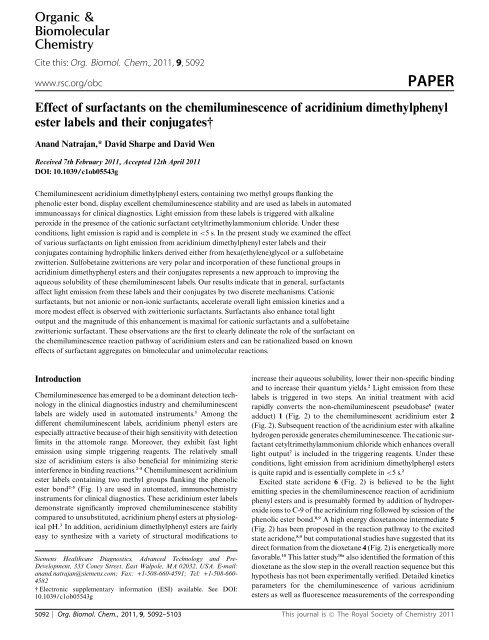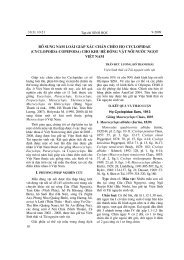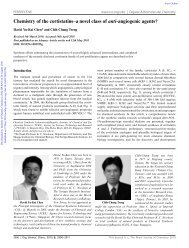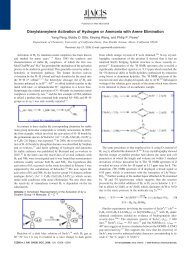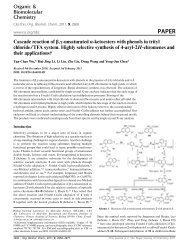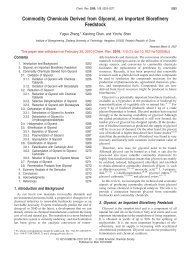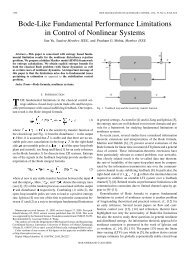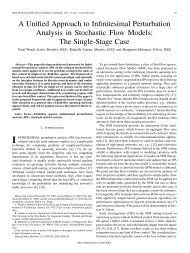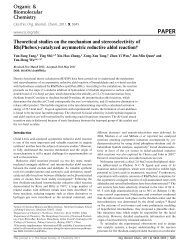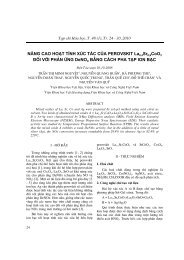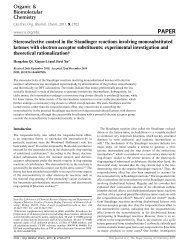PAPER Effect of surfactants on the chemiluminescence of acridinium ...
PAPER Effect of surfactants on the chemiluminescence of acridinium ...
PAPER Effect of surfactants on the chemiluminescence of acridinium ...
Create successful ePaper yourself
Turn your PDF publications into a flip-book with our unique Google optimized e-Paper software.
Organic &<br />
Biomolecular<br />
Chemistry<br />
Cite this: Org. Biomol. Chem., 2011, 9, 5092<br />
www.rsc.org/obc <str<strong>on</strong>g>PAPER</str<strong>on</strong>g><br />
<str<strong>on</strong>g>Effect</str<strong>on</strong>g> <str<strong>on</strong>g>of</str<strong>on</strong>g> <str<strong>on</strong>g>surfactants</str<strong>on</strong>g> <strong>on</strong> <strong>the</strong> <strong>chemiluminescence</strong> <str<strong>on</strong>g>of</str<strong>on</strong>g> <strong>acridinium</strong> dimethylphenyl<br />
ester labels and <strong>the</strong>ir c<strong>on</strong>jugates†<br />
Anand Natrajan,* David Sharpe and David Wen<br />
Received 7th February 2011, Accepted 12th April 2011<br />
DOI: 10.1039/c1ob05543g<br />
Chemiluminescent <strong>acridinium</strong> dimethylphenyl esters, c<strong>on</strong>taining two methyl groups flanking <strong>the</strong><br />
phenolic ester b<strong>on</strong>d, display excellent <strong>chemiluminescence</strong> stability and are used as labels in automated<br />
immunoassays for clinical diagnostics. Light emissi<strong>on</strong> from <strong>the</strong>se labels is triggered with alkaline<br />
peroxide in <strong>the</strong> presence <str<strong>on</strong>g>of</str<strong>on</strong>g> <strong>the</strong> cati<strong>on</strong>ic surfactant cetyltrimethylamm<strong>on</strong>ium chloride. Under <strong>the</strong>se<br />
c<strong>on</strong>diti<strong>on</strong>s, light emissi<strong>on</strong> is rapid and is complete in
Fig. 1 Structures <str<strong>on</strong>g>of</str<strong>on</strong>g> <strong>acridinium</strong> ester labels 1a and 1b, <strong>the</strong>ophylline c<strong>on</strong>jugates 2a and 2b and, NHS ester labels 3a and 3b used for protein labeling.<br />
Fig. 2 Simplified reacti<strong>on</strong> pathway for <strong>chemiluminescence</strong> from <strong>acridinium</strong> esters. R = –CH 2CH 2CH 2SO 3 - for compounds 1a, 1b, 2a, 2b and protein<br />
c<strong>on</strong>jugates <str<strong>on</strong>g>of</str<strong>on</strong>g> 3a and 3b. Formati<strong>on</strong> <str<strong>on</strong>g>of</str<strong>on</strong>g> both dioxetane 4 and dioxetan<strong>on</strong>e 5 involve dispersal <str<strong>on</strong>g>of</str<strong>on</strong>g> negative charge in <strong>the</strong> transiti<strong>on</strong> states <str<strong>on</strong>g>of</str<strong>on</strong>g> <strong>the</strong>se reacti<strong>on</strong>s.<br />
This journal is © The Royal Society <str<strong>on</strong>g>of</str<strong>on</strong>g> Chemistry 2011 Org. Biomol. Chem., 2011, 9, 5092–5103 | 5093
acrid<strong>on</strong>es in various solvents have also been recently reported 10b,c<br />
and <strong>the</strong>y support <strong>the</strong> noti<strong>on</strong> that excited state acrid<strong>on</strong>e is <strong>the</strong><br />
primary emitter. Decompositi<strong>on</strong> <str<strong>on</strong>g>of</str<strong>on</strong>g> <strong>the</strong> dioxetane 4 or dioxetan<strong>on</strong>e<br />
5 is postulated to occur by electr<strong>on</strong> transfer from <strong>the</strong> acridine<br />
nitrogen to <strong>the</strong> peroxide b<strong>on</strong>d 9–11 by a mechanism analogous to<br />
<strong>the</strong> CIEEL (chemically initiated electr<strong>on</strong>-exchange luminescence)<br />
mechanism proposed by Schuster. 12 A simplified versi<strong>on</strong> <str<strong>on</strong>g>of</str<strong>on</strong>g> <strong>the</strong><br />
reacti<strong>on</strong> pathway leading to <strong>chemiluminescence</strong> from <strong>acridinium</strong><br />
esters is illustrated in Fig. 2.<br />
In a previously reported study, <strong>the</strong> cati<strong>on</strong>ic surfactant<br />
cetyltrimethylamm<strong>on</strong>ium chloride was observed to enhance overall<br />
light output from an <strong>acridinium</strong> dimethylphenyl ester c<strong>on</strong>taining<br />
an N-methyl group. 7 Similar effects <str<strong>on</strong>g>of</str<strong>on</strong>g> <str<strong>on</strong>g>surfactants</str<strong>on</strong>g> in<br />
enhancing <strong>the</strong> luminescence <str<strong>on</strong>g>of</str<strong>on</strong>g> o<strong>the</strong>r chemiluminescent labels such<br />
as luminol, 13 peroxyoxalates 14 and dioxetanes 15 have also been<br />
observed. In a study that examined <strong>the</strong> effect <str<strong>on</strong>g>of</str<strong>on</strong>g> <str<strong>on</strong>g>surfactants</str<strong>on</strong>g> <strong>on</strong><br />
<strong>the</strong> <strong>chemiluminescence</strong> <str<strong>on</strong>g>of</str<strong>on</strong>g> <strong>acridinium</strong> phenyl ester labels lacking<br />
<strong>the</strong> dimethyl groups, antibody c<strong>on</strong>jugates <str<strong>on</strong>g>of</str<strong>on</strong>g> <strong>the</strong>se labels were<br />
observed to exhibit <strong>the</strong> greatest increase in <strong>chemiluminescence</strong><br />
in <strong>the</strong> presence <str<strong>on</strong>g>of</str<strong>on</strong>g> <strong>the</strong> n<strong>on</strong>-i<strong>on</strong>ic surfactant trit<strong>on</strong> X-100, whereas<br />
cetyltrimethylamm<strong>on</strong>ium chloride was most effective for albumin<br />
c<strong>on</strong>jugates. 16<br />
In <strong>the</strong> current study, we examined <strong>the</strong> effect <str<strong>on</strong>g>of</str<strong>on</strong>g> cati<strong>on</strong>ic,<br />
zwitteri<strong>on</strong>ic, ani<strong>on</strong>ic and n<strong>on</strong>-i<strong>on</strong>ic <str<strong>on</strong>g>surfactants</str<strong>on</strong>g> <strong>on</strong> light emissi<strong>on</strong><br />
from two hydrophilic <strong>acridinium</strong> dimethylphenyl ester labels as<br />
well as <strong>the</strong>ir c<strong>on</strong>jugates (Fig. 1) that are currently used in<br />
automated immunoassays. The purpose <str<strong>on</strong>g>of</str<strong>on</strong>g> this study was mainly<br />
to elucidate <strong>the</strong> role <str<strong>on</strong>g>of</str<strong>on</strong>g> <strong>the</strong> surfactant <strong>on</strong> <strong>the</strong> <strong>chemiluminescence</strong><br />
from <strong>the</strong>se hydrophilic labels especially pertaining to <strong>the</strong> reacti<strong>on</strong><br />
pathway illustrated in Fig. 2. We felt that a better understanding <str<strong>on</strong>g>of</str<strong>on</strong>g><br />
<strong>the</strong> role <str<strong>on</strong>g>of</str<strong>on</strong>g> <strong>the</strong> surfactant was needed to determine whe<strong>the</strong>r <strong>the</strong>re is<br />
scope for fur<strong>the</strong>r enhancement <str<strong>on</strong>g>of</str<strong>on</strong>g> <strong>the</strong> <strong>chemiluminescence</strong> <str<strong>on</strong>g>of</str<strong>on</strong>g> <strong>the</strong>se<br />
labels. From a practical point <str<strong>on</strong>g>of</str<strong>on</strong>g> view, increased light output from<br />
<strong>the</strong>se labels would be beneficial in improving assay sensitivity <str<strong>on</strong>g>of</str<strong>on</strong>g><br />
clinically important analytes.<br />
Results and discussi<strong>on</strong><br />
Acridinium esters and c<strong>on</strong>jugates<br />
Hydrophilic <strong>acridinium</strong> dimethylphenyl esters (Fig. 1) display<br />
excellent <strong>chemiluminescence</strong> stability and low n<strong>on</strong>-specific<br />
binding, 2,5 and are used as labels in automated immunoassays. In<br />
<strong>the</strong> current study, <strong>the</strong> free labels 1a and 1b in Fig. 1 were used<br />
for <strong>the</strong> preparati<strong>on</strong> <str<strong>on</strong>g>of</str<strong>on</strong>g> small molecule <strong>the</strong>ophylline c<strong>on</strong>jugates 2a<br />
and 2b. Protein c<strong>on</strong>jugates were prepared using <strong>the</strong> NHS (Nhydroxysuccinimidyl)<br />
ester derivatives 3a and 3b. Compound 1a<br />
with an unsubstituted N-sulfopropyl <strong>acridinium</strong> ring c<strong>on</strong>tains<br />
a hydrophilic linker derived from hexa(ethylene)glycol which is<br />
attached para to <strong>the</strong> phenolic ester b<strong>on</strong>d. This linker increases<br />
aqueous solubility <str<strong>on</strong>g>of</str<strong>on</strong>g> <strong>the</strong> label and facilitates c<strong>on</strong>jugate syn<strong>the</strong>sis<br />
and protein labeling. 5 Compound 1b is structurally distinct from<br />
1a and c<strong>on</strong>tains a hydrophilic linker with a sulfobetaine zwitteri<strong>on</strong>.<br />
Zwitteri<strong>on</strong>s are highly hydrophilic and appear to complement<br />
poly(ethylene)glycol in <strong>the</strong>ir ability to reduce n<strong>on</strong>-specific binding<br />
<str<strong>on</strong>g>of</str<strong>on</strong>g> proteins. 17 Recent studies have shown that surfaces functi<strong>on</strong>alized<br />
with zwitteri<strong>on</strong>s such as sulfobetaines and carboxybetaines<br />
are extremely resistant to protein adsorpti<strong>on</strong>, fouling and bi<str<strong>on</strong>g>of</str<strong>on</strong>g>ilm<br />
formati<strong>on</strong>. 17 The incorporati<strong>on</strong> <str<strong>on</strong>g>of</str<strong>on</strong>g> a zwitteri<strong>on</strong>ic linker such as<br />
that present in compound 1b thus represents a complementary<br />
approach towards increasing <strong>the</strong> aqueous solubility and lowering<br />
<strong>the</strong> n<strong>on</strong>-specific binding <str<strong>on</strong>g>of</str<strong>on</strong>g> <strong>acridinium</strong> ester labels.<br />
The syn<strong>the</strong>ses <str<strong>on</strong>g>of</str<strong>on</strong>g> compounds 1a–3a have been described<br />
previously. 2,5 Syn<strong>the</strong>ses <str<strong>on</strong>g>of</str<strong>on</strong>g> compounds 1b, 2b and 3b c<strong>on</strong>taining <strong>the</strong><br />
zwitteri<strong>on</strong>ic sulfobetaine linker are illustrated in Fig. 3 and were<br />
accomplished in a straightforward manner using commercially<br />
available reagents. The zwitteri<strong>on</strong>ic linker iv itself was syn<strong>the</strong>sizedinthreestepsfromN,N-bis(3-aminopropyl)methylamine<br />
as described in <strong>the</strong> Experimental secti<strong>on</strong>. The primary amines<br />
in N,N-bis(3-aminopropyl)methylamine i were first c<strong>on</strong>verted to<br />
<strong>the</strong> benzyl carbamates, following which <strong>the</strong> protected derivative<br />
ii was N-alkylated at <strong>the</strong> tertiary amine with 1,3-propane sult<strong>on</strong>e<br />
to give compound iii. Deprotecti<strong>on</strong> <str<strong>on</strong>g>of</str<strong>on</strong>g> <strong>the</strong> primary amines in iii<br />
gave <strong>the</strong> zwitteri<strong>on</strong>ic linker iv. The linker iv was next coupled<br />
to <strong>acridinium</strong> ester v 4,5 to give compound 1b which was purified<br />
by preparative HPLC. C<strong>on</strong>versi<strong>on</strong> <str<strong>on</strong>g>of</str<strong>on</strong>g> 1b to <strong>the</strong> <strong>the</strong>ophylline<br />
c<strong>on</strong>jugate 2b was accomplished in <strong>on</strong>e step by coupling to commercially<br />
available 8-carboxypropyl<strong>the</strong>ophylline using (benzotriazol-<br />
1-yl-oxy)tris(dimethylamino)phosph<strong>on</strong>ium hexafluorophosphate<br />
(BOP) followed by HPLC purificati<strong>on</strong>. C<strong>on</strong>versi<strong>on</strong> <str<strong>on</strong>g>of</str<strong>on</strong>g> 1b to<br />
<strong>the</strong> NHS ester label 3b was accomplished by first c<strong>on</strong>densing<br />
1b with glutaric anhydride followed by activati<strong>on</strong> <str<strong>on</strong>g>of</str<strong>on</strong>g> <strong>the</strong> resulting<br />
carboxylate derivative with N,N,N¢,N¢-tetramethyl-O-(Nsuccinimidyl)ur<strong>on</strong>ium<br />
tetrafluoroborate (TSTU). Compound 3b<br />
was purified by HPLC prior to protein labeling.<br />
Protein c<strong>on</strong>jugates <str<strong>on</strong>g>of</str<strong>on</strong>g> <strong>the</strong> labels 3a and 3b were prepared,<br />
as described in <strong>the</strong> experimental secti<strong>on</strong>, using three different<br />
proteins; a murine anti-TSH m<strong>on</strong>ocl<strong>on</strong>al antibody with an acidic<br />
pI = 5.6 (TSH = Thyroid Stimulating Horm<strong>on</strong>e); a murine anti-<br />
HBsAg m<strong>on</strong>ocl<strong>on</strong>al antibody with a pI = 7 (HBsAg = Hepatitis B<br />
Surface Antigen) and egg white avidin with a basic pI = 10.5. 18 All<br />
three labels displayed similar reactivity towards <strong>the</strong> three proteins<br />
and <strong>the</strong> extent <str<strong>on</strong>g>of</str<strong>on</strong>g> label incorporati<strong>on</strong> was very similar as described<br />
in <strong>the</strong> Experimental secti<strong>on</strong>. Using an input <str<strong>on</strong>g>of</str<strong>on</strong>g> 10 equivalents<br />
<str<strong>on</strong>g>of</str<strong>on</strong>g> <strong>the</strong> <strong>acridinium</strong> ester labels 3a and 3b, approximately 5 labels<br />
were incorporated in each protein as measured by MALDI-TOF<br />
(Matrix-Assisted Laser Desorpti<strong>on</strong> I<strong>on</strong>izati<strong>on</strong>-Time <str<strong>on</strong>g>of</str<strong>on</strong>g> Flight)<br />
mass spectrometry.<br />
Surfactants and light measurement protocol<br />
Previous studies 7,16 that examined <strong>the</strong> effect <str<strong>on</strong>g>of</str<strong>on</strong>g> <str<strong>on</strong>g>surfactants</str<strong>on</strong>g> <strong>on</strong><br />
<strong>acridinium</strong> ester <strong>chemiluminescence</strong> noted an enhancement <str<strong>on</strong>g>of</str<strong>on</strong>g><br />
<strong>chemiluminescence</strong> in <strong>the</strong> presence <str<strong>on</strong>g>of</str<strong>on</strong>g> <str<strong>on</strong>g>surfactants</str<strong>on</strong>g> but <strong>the</strong> mechanism<br />
leading to this enhancement was not defined clearly. Micellar<br />
catalysis <str<strong>on</strong>g>of</str<strong>on</strong>g> bimolecular reacti<strong>on</strong>s largely results from increased<br />
local c<strong>on</strong>centrati<strong>on</strong>s <str<strong>on</strong>g>of</str<strong>on</strong>g> <strong>the</strong> reactants in a small volume <str<strong>on</strong>g>of</str<strong>on</strong>g> <strong>the</strong><br />
micellar phase. 19 An important property <str<strong>on</strong>g>of</str<strong>on</strong>g> i<strong>on</strong>ic micelles, that<br />
makes <strong>the</strong>m effective catalysts <str<strong>on</strong>g>of</str<strong>on</strong>g> bimolecular reacti<strong>on</strong>s, is <strong>the</strong>ir<br />
ability to bind various substrates and attract oppositely charged<br />
reactive i<strong>on</strong>s to <strong>the</strong>ir surfaces. The increased local c<strong>on</strong>centrati<strong>on</strong><br />
<str<strong>on</strong>g>of</str<strong>on</strong>g> <strong>the</strong> two reactants is manifested by an increase in <strong>the</strong> observed<br />
reacti<strong>on</strong> rate. Surfactant aggregates also have significant effects <strong>on</strong><br />
<strong>the</strong> rates <str<strong>on</strong>g>of</str<strong>on</strong>g> unimolecular reacti<strong>on</strong>s such as <strong>the</strong> decarboxylati<strong>on</strong><br />
<str<strong>on</strong>g>of</str<strong>on</strong>g> 6-nitrobenzisoxazole-3-carboxylate, <strong>the</strong> intramolecular cyclizati<strong>on</strong><br />
reacti<strong>on</strong>s <str<strong>on</strong>g>of</str<strong>on</strong>g> ortho-haloalkyl-substituted phenoxides and<br />
1,2-eliminati<strong>on</strong> reacti<strong>on</strong>s. 20,21 All <strong>the</strong>se reacti<strong>on</strong>s involve charge<br />
dispersal in <strong>the</strong>ir transiti<strong>on</strong> states leading to products and are<br />
5094 | Org. Biomol. Chem., 2011, 9, 5092–5103 This journal is © The Royal Society <str<strong>on</strong>g>of</str<strong>on</strong>g> Chemistry 2011
Fig. 3 Syn<strong>the</strong>tic scheme for 1b, 2b and 3b. Reagents: (a) N-(benzyloxycarb<strong>on</strong>yloxy)succinimide, chlor<str<strong>on</strong>g>of</str<strong>on</strong>g>orm; (b) 1,3-propane sult<strong>on</strong>e, ethyl acetate; (c)<br />
33% hydrogen bromide in acetic acid; (d) 0.25 M sodium bicarb<strong>on</strong>ate/dimethyl formamide; (e) glutaric anhydride, diisopropylethylamine, water/methanol;<br />
(f) TSTU, diisopropylethylamine, water/dimethyl formamide; (g) 8-carboxypropyl<strong>the</strong>ophylline, BOP reagent, diisopropylethylamine, dimethyl sulfoxide.<br />
catalyzed by various cati<strong>on</strong>ic and zwitteri<strong>on</strong>ic <str<strong>on</strong>g>surfactants</str<strong>on</strong>g> resulting<br />
from reduced medium polarity <str<strong>on</strong>g>of</str<strong>on</strong>g> <strong>the</strong> micellar envir<strong>on</strong>ment. 20,21<br />
Light emissi<strong>on</strong> from <strong>acridinium</strong> dimethylphenyl esters that are<br />
used as chemiluminescent labels in automated immunoassays is<br />
triggered by <strong>the</strong> sequential additi<strong>on</strong> <str<strong>on</strong>g>of</str<strong>on</strong>g> equal volumes (0.3 mL)<br />
<str<strong>on</strong>g>of</str<strong>on</strong>g> two reagents. An initial treatment with 0.1 M nitric acid<br />
c<strong>on</strong>taining 0.5% hydrogen peroxide (Reagent 1) is followed by<br />
<strong>the</strong> additi<strong>on</strong> <str<strong>on</strong>g>of</str<strong>on</strong>g> 0.25 M sodium hydroxide c<strong>on</strong>taining 7 mM <str<strong>on</strong>g>of</str<strong>on</strong>g><br />
<strong>the</strong> cati<strong>on</strong>ic surfactant cetyltrimethylamm<strong>on</strong>ium chloride (CTAC)<br />
(Reagent 2).<br />
In <strong>the</strong> current study, we examined <strong>the</strong> effect <str<strong>on</strong>g>of</str<strong>on</strong>g> different<br />
<str<strong>on</strong>g>surfactants</str<strong>on</strong>g> in Reagent 2 <strong>on</strong> emissi<strong>on</strong> kinetics as well as total<br />
light emitted from <strong>the</strong> <strong>acridinium</strong> ester labels and c<strong>on</strong>jugates.<br />
Specifically, light emissi<strong>on</strong> from each label or c<strong>on</strong>jugate was<br />
measured for a period <str<strong>on</strong>g>of</str<strong>on</strong>g> two minutes (in 0.5 s intervals) which was<br />
sufficiently l<strong>on</strong>g for >90% emissi<strong>on</strong> under all c<strong>on</strong>diti<strong>on</strong>s. Emissi<strong>on</strong><br />
kinetics, as reflected by <strong>the</strong> time required for >90% emissi<strong>on</strong> <str<strong>on</strong>g>of</str<strong>on</strong>g><br />
light from <strong>the</strong> labels and <strong>the</strong>ir c<strong>on</strong>jugates, are tabulated in Tables 1<br />
and 2 for <strong>the</strong> free labels 1a and 1b, <strong>the</strong> <strong>the</strong>ophylline c<strong>on</strong>jugates<br />
2a and 2b as well <strong>the</strong> different protein c<strong>on</strong>jugates <str<strong>on</strong>g>of</str<strong>on</strong>g> <strong>the</strong> labels 3a<br />
and 3b. These emissi<strong>on</strong> times reflect <strong>the</strong> effect <str<strong>on</strong>g>of</str<strong>on</strong>g> <strong>the</strong> surfactant<br />
in ei<strong>the</strong>r accelerating or inhibiting <strong>the</strong> <strong>chemiluminescence</strong> rate <str<strong>on</strong>g>of</str<strong>on</strong>g><br />
<strong>the</strong> <strong>acridinium</strong> ester labels and c<strong>on</strong>jugates. The total amount <str<strong>on</strong>g>of</str<strong>on</strong>g><br />
light emitted at <strong>the</strong> two minute measurement time, in <strong>the</strong> presence<br />
<str<strong>on</strong>g>of</str<strong>on</strong>g> various <str<strong>on</strong>g>surfactants</str<strong>on</strong>g>, was used to calculate <strong>the</strong> effect <str<strong>on</strong>g>of</str<strong>on</strong>g> <strong>the</strong><br />
surfactant <strong>on</strong> light output (relative quantum yield). Total light<br />
output in <strong>the</strong> absence <str<strong>on</strong>g>of</str<strong>on</strong>g> surfactant was normalized to a value <str<strong>on</strong>g>of</str<strong>on</strong>g><br />
<strong>on</strong>e for all labels and c<strong>on</strong>jugates. Relative light output values in<br />
<strong>the</strong> presence <str<strong>on</strong>g>of</str<strong>on</strong>g> <str<strong>on</strong>g>surfactants</str<strong>on</strong>g> are listed in Tables 3 and 4 for <strong>the</strong><br />
free labels, <strong>the</strong> <strong>the</strong>ophylline c<strong>on</strong>jugates and <strong>the</strong> protein c<strong>on</strong>jugates.<br />
This journal is © The Royal Society <str<strong>on</strong>g>of</str<strong>on</strong>g> Chemistry 2011 Org. Biomol. Chem., 2011, 9, 5092–5103 | 5095
Table 1 Time (sec<strong>on</strong>ds a ) for emissi<strong>on</strong> <str<strong>on</strong>g>of</str<strong>on</strong>g> >90% total light <str<strong>on</strong>g>of</str<strong>on</strong>g> <strong>acridinium</strong> esters 1a and 1b and <strong>the</strong>ophylline c<strong>on</strong>jugates 2a and 2b in <strong>the</strong> presence <str<strong>on</strong>g>of</str<strong>on</strong>g><br />
different <str<strong>on</strong>g>surfactants</str<strong>on</strong>g><br />
Compound No surfactant CTAC CTAOH CTPAC CTBAC DDAO DDAPS SDS Trit<strong>on</strong> X-100<br />
1a 60.0 1.5 1.5 1.5 4.0 40.5 10.0 67.0 57.5<br />
1b 67.5 1.0 1.0 1.5 3.0 40.0 7.0 63.0 61.0<br />
2a 55.5 2.5 2.5 1.5 1.5 42.5 14.0 60.0 56.0<br />
2b 62.0 1.5 1.5 1.5 1.5 42.0 9.5 60.5 59.5<br />
a Average <str<strong>on</strong>g>of</str<strong>on</strong>g> five replicates. Abbreviati<strong>on</strong>s used: CTAC = cetyltrimethylamm<strong>on</strong>ium chloride (cati<strong>on</strong>ic); CTAOH = cetyltrimethylamm<strong>on</strong>ium hydroxide<br />
(cati<strong>on</strong>ic); CTPAC = cetyltripropylamm<strong>on</strong>ium chloride (cati<strong>on</strong>ic); CTBAC = cetyltributylamm<strong>on</strong>ium chloride (cati<strong>on</strong>ic); DDAO = N,Ndimethyldodecylamine<br />
oxide (zwitteri<strong>on</strong>ic); DDAPS = N,N-dimethyldodecylamm<strong>on</strong>io-1,3-propane sulf<strong>on</strong>ate (zwitteri<strong>on</strong>ic); SDS = sodium dodecyl<br />
sulfate (ani<strong>on</strong>ic); Trit<strong>on</strong> X-100 (n<strong>on</strong>-i<strong>on</strong>ic).<br />
Table 2 Time (sec<strong>on</strong>ds a ) for emissi<strong>on</strong> <str<strong>on</strong>g>of</str<strong>on</strong>g> >90% total light <str<strong>on</strong>g>of</str<strong>on</strong>g> <strong>acridinium</strong> ester–protein c<strong>on</strong>jugates <str<strong>on</strong>g>of</str<strong>on</strong>g> labels 3a and 3b in <strong>the</strong> presence <str<strong>on</strong>g>of</str<strong>on</strong>g> different<br />
<str<strong>on</strong>g>surfactants</str<strong>on</strong>g><br />
C<strong>on</strong>jugate No surfactant CTAC CTAOH CTPAC CTBAC DDAO DDAPS SDS Trit<strong>on</strong> X-100<br />
Anti-TSH Mab-3a 64.5 2.5 3.0 3.0 3.5 46.5 14.5 89.0 62.5<br />
Anti-TSH Mab-3b 61.5 1.5 3.0 2.0 2.5 40.0 9.5 86.5 59.5<br />
Anti-HBsAg Mab-3a 64.5 3.0 3.0 5.0 5.5 46.0 13.5 90.5 61.0<br />
Anti-HBsAg Mab-3b 60.5 2.0 3.0 3.0 4.0 39.0 9.0 88.0 58.5<br />
Avidin-3a 89.5 3.5 3.0 21.0 9.0 72.5 61.0 87.5 89.0<br />
Avidin-3b 74.5 1.0 1.5 2.5 2.0 53.0 29.0 80.0 73.5<br />
a Average <str<strong>on</strong>g>of</str<strong>on</strong>g> five replicates.<br />
Table 3 Observed enhancement <str<strong>on</strong>g>of</str<strong>on</strong>g> light output <str<strong>on</strong>g>of</str<strong>on</strong>g> <strong>acridinium</strong> esters 1a and 1b and <strong>the</strong>ophylline c<strong>on</strong>jugates 2a and 2b in <strong>the</strong> presence <str<strong>on</strong>g>of</str<strong>on</strong>g> different<br />
<str<strong>on</strong>g>surfactants</str<strong>on</strong>g> at a measurement time <str<strong>on</strong>g>of</str<strong>on</strong>g> two minutes<br />
Compound No surfactant CTAC CTAOH CTPAC CTBAC DDAO DDAPS SDS Trit<strong>on</strong> X-100<br />
1a 1 3.2 3.4 3.6 3.3 2.4 3.9 1.3 1.5<br />
1b 1 2.9 3.2 3.2 3.0 2.3 3.7 1.3 1.4<br />
2a 1 2.7 3.1 3.5 3.3 2.1 3.4 1.4 1.4<br />
2b 1 2.9 3.0 3.3 3.3 2.4 3.8 1.3 1.4<br />
Table 4 Observed enhancement <str<strong>on</strong>g>of</str<strong>on</strong>g> light output <str<strong>on</strong>g>of</str<strong>on</strong>g> <strong>acridinium</strong> ester–protein c<strong>on</strong>jugates <str<strong>on</strong>g>of</str<strong>on</strong>g> labels 3a and 3b in <strong>the</strong> presence <str<strong>on</strong>g>of</str<strong>on</strong>g> different <str<strong>on</strong>g>surfactants</str<strong>on</strong>g> at a<br />
measurement time <str<strong>on</strong>g>of</str<strong>on</strong>g> two minutes<br />
C<strong>on</strong>jugate No surfactant CTAC CTAOH CTPAC CTBAC DDAO DDAPS SDS Trit<strong>on</strong> X-100<br />
Anti-TSH Mab-3a 1 3.1 3.2 3.4 3.6 2.6 4.1 1.2 1.4<br />
Anti-TSH Mab-3b 1 2.1 2.3 2.2 2.4 2.4 3.7 1.1 1.4<br />
Anti-HBsAg Mab-3a 1 3.2 3.2 3.5 3.6 4.6 7.3 1.1 1.5<br />
Anti-HBsAg Mab-3b 1 2.4 2.6 2.7 2.8 2.5 3.9 1.1 1.4<br />
Avidin-3a 1 4.9 4.8 5.6 5.5 3.5 5.7 1.5 1.4<br />
Avidin-3b 1 2.7 2.6 3.2 3.2 2.8 4.4 1.3 1.4<br />
Thus, Tables 3 and 4 reflect <strong>the</strong> ability <str<strong>on</strong>g>of</str<strong>on</strong>g> <strong>the</strong> various <str<strong>on</strong>g>surfactants</str<strong>on</strong>g><br />
tested to enhance <strong>the</strong> total light emitted by <strong>the</strong> <strong>acridinium</strong> ester<br />
labels and c<strong>on</strong>jugates.<br />
Chemiluminescence measurements were made using 10 femtomoles<br />
(femtomole = 10 -15 mole) <str<strong>on</strong>g>of</str<strong>on</strong>g> <strong>acridinium</strong> labels 1a and 1b and<br />
<strong>the</strong>ophylline c<strong>on</strong>jugates 2a and 2b and 2.5 femtomoles <str<strong>on</strong>g>of</str<strong>on</strong>g> protein<br />
c<strong>on</strong>jugates in a total volume <str<strong>on</strong>g>of</str<strong>on</strong>g> 0.6 mL. Surfactant c<strong>on</strong>centrati<strong>on</strong>s<br />
in Reagent 2 were five times its reported CMC (critical micelle<br />
c<strong>on</strong>centrati<strong>on</strong>) in water. Final c<strong>on</strong>centrati<strong>on</strong> <str<strong>on</strong>g>of</str<strong>on</strong>g> reagents was 0.25%<br />
(~80 mM) peroxide in 0.125 M sodium hydroxide and <strong>the</strong> final<br />
c<strong>on</strong>centrati<strong>on</strong> <str<strong>on</strong>g>of</str<strong>on</strong>g> <strong>the</strong> surfactant was 2.5 times its reported CMC<br />
in water. Thus, c<strong>on</strong>centrati<strong>on</strong>s <str<strong>on</strong>g>of</str<strong>on</strong>g> peroxide and surfactant were in<br />
vast excess compared to c<strong>on</strong>centrati<strong>on</strong>s <str<strong>on</strong>g>of</str<strong>on</strong>g> <strong>the</strong> <strong>acridinium</strong> ester<br />
labels and <strong>the</strong>ir c<strong>on</strong>jugates. Details <str<strong>on</strong>g>of</str<strong>on</strong>g> <strong>the</strong>se measurements can be<br />
found in <strong>the</strong> experimental secti<strong>on</strong>.<br />
Am<strong>on</strong>g <strong>the</strong> different cati<strong>on</strong>ic <str<strong>on</strong>g>surfactants</str<strong>on</strong>g>, we examined <strong>the</strong> effect<br />
<str<strong>on</strong>g>of</str<strong>on</strong>g> <strong>the</strong> counteri<strong>on</strong> <str<strong>on</strong>g>of</str<strong>on</strong>g> cetyltrimethylamm<strong>on</strong>ium salts as represented<br />
by <strong>the</strong> <str<strong>on</strong>g>surfactants</str<strong>on</strong>g> CTAOH (with hydroxide counteri<strong>on</strong>s) and<br />
CTAC (with chloride counteri<strong>on</strong>s). Hydroxide i<strong>on</strong>s are reported<br />
to bind weakly to cetyltrimethylamm<strong>on</strong>ium micelles and this is<br />
reflected in <strong>the</strong> increased CMC and i<strong>on</strong>izati<strong>on</strong> c<strong>on</strong>stant a <str<strong>on</strong>g>of</str<strong>on</strong>g><br />
CTAOH when compared to CTAC. 22 The reactive i<strong>on</strong>s in <strong>the</strong><br />
<strong>chemiluminescence</strong> reacti<strong>on</strong> <str<strong>on</strong>g>of</str<strong>on</strong>g> <strong>acridinium</strong> esters are hydroperoxide<br />
i<strong>on</strong>s which have been reported to display similar affinity to<br />
cetyltrimethylamm<strong>on</strong>ium micelles as hydroxide i<strong>on</strong>s. 23 The effect<br />
<str<strong>on</strong>g>of</str<strong>on</strong>g> head group size in cati<strong>on</strong>ic <str<strong>on</strong>g>surfactants</str<strong>on</strong>g> was also tested by<br />
including <strong>the</strong> <str<strong>on</strong>g>surfactants</str<strong>on</strong>g> cetyltripropylamm<strong>on</strong>ium chloride (CT-<br />
PAC) cetyltributylamm<strong>on</strong>ium chloride (CTBAC). 24 Aggregates <str<strong>on</strong>g>of</str<strong>on</strong>g><br />
both <strong>the</strong>se <str<strong>on</strong>g>surfactants</str<strong>on</strong>g> have been reported to bind ani<strong>on</strong>s less<br />
str<strong>on</strong>gly than cetyltrimethylamm<strong>on</strong>ium micelles owing to reduced<br />
5096 | Org. Biomol. Chem., 2011, 9, 5092–5103 This journal is © The Royal Society <str<strong>on</strong>g>of</str<strong>on</strong>g> Chemistry 2011
polarity <str<strong>on</strong>g>of</str<strong>on</strong>g> <strong>the</strong>ir head groups which is reflected in lower CMC<br />
values <str<strong>on</strong>g>of</str<strong>on</strong>g> <strong>the</strong>se <str<strong>on</strong>g>surfactants</str<strong>on</strong>g> compared to CTAC. 24 Two zwitteri<strong>on</strong>ic<br />
<str<strong>on</strong>g>surfactants</str<strong>on</strong>g>, DDAO (N,N-dimethyldodecylamine oxide) and<br />
DDAPS (N,N-dimethyldodecylamm<strong>on</strong>io-1,3-propane sulf<strong>on</strong>ate)<br />
were included in <strong>the</strong> current study to examine <strong>the</strong>ir effects<br />
<strong>on</strong> <strong>acridinium</strong> ester <strong>chemiluminescence</strong>. While aggregates<br />
<str<strong>on</strong>g>of</str<strong>on</strong>g> <strong>the</strong>se <str<strong>on</strong>g>surfactants</str<strong>on</strong>g> are reported to attract ani<strong>on</strong>s <strong>on</strong>ly<br />
weakly, 25,26 <strong>the</strong>y <str<strong>on</strong>g>of</str<strong>on</strong>g>fer a n<strong>on</strong>-polar envir<strong>on</strong>ment similar to cati<strong>on</strong>ic<br />
micelles. 20,21 Finally, <strong>the</strong> effects <str<strong>on</strong>g>of</str<strong>on</strong>g> <strong>the</strong> ani<strong>on</strong>ic surfactant SDS<br />
(sodium dodecyl sulfate) and <strong>the</strong> n<strong>on</strong>-i<strong>on</strong>ic surfactant trit<strong>on</strong><br />
X-100 <strong>on</strong> <strong>acridinium</strong> ester <strong>chemiluminescence</strong> were also<br />
investigated.<br />
<str<strong>on</strong>g>Effect</str<strong>on</strong>g> <str<strong>on</strong>g>of</str<strong>on</strong>g> <str<strong>on</strong>g>surfactants</str<strong>on</strong>g> <strong>on</strong> light emissi<strong>on</strong> kinetics<br />
The effect <str<strong>on</strong>g>of</str<strong>on</strong>g> <str<strong>on</strong>g>surfactants</str<strong>on</strong>g> <strong>on</strong> emissi<strong>on</strong> kinetics <str<strong>on</strong>g>of</str<strong>on</strong>g> <strong>the</strong> two <strong>acridinium</strong><br />
ester labels and <strong>the</strong>ir c<strong>on</strong>jugates is illustrated in Tables 1 and 2.<br />
Light emissi<strong>on</strong> pr<str<strong>on</strong>g>of</str<strong>on</strong>g>iles for <strong>the</strong> labels 1a and 1b are illustrated in<br />
Fig. 4 and 5, in <strong>the</strong> presence and absence <str<strong>on</strong>g>of</str<strong>on</strong>g> <str<strong>on</strong>g>surfactants</str<strong>on</strong>g>. Emissi<strong>on</strong><br />
pr<str<strong>on</strong>g>of</str<strong>on</strong>g>iles <str<strong>on</strong>g>of</str<strong>on</strong>g> <strong>the</strong> <strong>the</strong>ophylline and protein c<strong>on</strong>jugates were similar<br />
and are illustrated in Fig. 6–13 <str<strong>on</strong>g>of</str<strong>on</strong>g> <strong>the</strong> ESI.† In <strong>the</strong> absence <str<strong>on</strong>g>of</str<strong>on</strong>g><br />
surfactant, light emissi<strong>on</strong> was quite slow for <strong>the</strong> labels and <strong>the</strong>ir<br />
c<strong>on</strong>jugates requiring a minute or more for >90% light emissi<strong>on</strong>.<br />
In <strong>the</strong> presence <str<strong>on</strong>g>of</str<strong>on</strong>g> <strong>the</strong> cetyltrialkylamm<strong>on</strong>ium <str<strong>on</strong>g>surfactants</str<strong>on</strong>g>, CTAC,<br />
CTAOH, CTPAC and CTBAC, light emissi<strong>on</strong> was observed to be<br />
Fig. 4 Light emissi<strong>on</strong> pr<str<strong>on</strong>g>of</str<strong>on</strong>g>iles <str<strong>on</strong>g>of</str<strong>on</strong>g> <strong>acridinium</strong> ester label 1a in <strong>the</strong> absence and in <strong>the</strong> presence <str<strong>on</strong>g>of</str<strong>on</strong>g> various <str<strong>on</strong>g>surfactants</str<strong>on</strong>g>.<br />
Fig. 5 Light emissi<strong>on</strong> pr<str<strong>on</strong>g>of</str<strong>on</strong>g>iles <str<strong>on</strong>g>of</str<strong>on</strong>g> <strong>acridinium</strong> ester label 1b in <strong>the</strong> absence and in <strong>the</strong> presence <str<strong>on</strong>g>of</str<strong>on</strong>g> various <str<strong>on</strong>g>surfactants</str<strong>on</strong>g>.<br />
This journal is © The Royal Society <str<strong>on</strong>g>of</str<strong>on</strong>g> Chemistry 2011 Org. Biomol. Chem., 2011, 9, 5092–5103 | 5097
significantly faster and emissi<strong>on</strong> times were compressed to ~5 s<br />
for <strong>the</strong> labels and <strong>the</strong>ir c<strong>on</strong>jugates. The <strong>on</strong>ly excepti<strong>on</strong> was <strong>the</strong><br />
avidin c<strong>on</strong>jugate <str<strong>on</strong>g>of</str<strong>on</strong>g> 3a which exhibited relatively slower emissi<strong>on</strong><br />
in <strong>the</strong> presence <str<strong>on</strong>g>of</str<strong>on</strong>g> CTPAC and CTBAC. Although aggregates <str<strong>on</strong>g>of</str<strong>on</strong>g><br />
CTPAC and CTBAC were expected to bind hydroperoxide i<strong>on</strong>s<br />
less str<strong>on</strong>gly than micelles <str<strong>on</strong>g>of</str<strong>on</strong>g> <strong>the</strong> two cetyltrimethylamm<strong>on</strong>ium<br />
<str<strong>on</strong>g>surfactants</str<strong>on</strong>g>, with <strong>the</strong> excepti<strong>on</strong> <str<strong>on</strong>g>of</str<strong>on</strong>g> <strong>the</strong> avidin c<strong>on</strong>jugate <str<strong>on</strong>g>of</str<strong>on</strong>g> 3a,wedid<br />
not observe a significant attenuati<strong>on</strong> in emissi<strong>on</strong> kinetics (Tables 1<br />
and 2) because <strong>the</strong> <str<strong>on</strong>g>surfactants</str<strong>on</strong>g> were in vast excess. Protein pI in<br />
general had little effect <strong>on</strong> <strong>the</strong> ability <str<strong>on</strong>g>of</str<strong>on</strong>g> <strong>the</strong> cati<strong>on</strong>ic <str<strong>on</strong>g>surfactants</str<strong>on</strong>g> in<br />
accelerating emissi<strong>on</strong> kinetics. From <strong>the</strong> emissi<strong>on</strong> times in Tables 1<br />
and 2, relative rate enhancements can be estimated by comparing<br />
<strong>the</strong> emissi<strong>on</strong> times in <strong>the</strong> absence <str<strong>on</strong>g>of</str<strong>on</strong>g> surfactant and in <strong>the</strong> presence<br />
<str<strong>on</strong>g>of</str<strong>on</strong>g> surfactant. These ratios indicate that <strong>the</strong> cati<strong>on</strong>ic <str<strong>on</strong>g>surfactants</str<strong>on</strong>g>,<br />
especially CTAC and CTAOH, increase emissi<strong>on</strong> rates by at least<br />
an order <str<strong>on</strong>g>of</str<strong>on</strong>g> magnitude for <strong>acridinium</strong> dimethylphenyl ester labels<br />
and <strong>the</strong>ir c<strong>on</strong>jugates.<br />
Zwitteri<strong>on</strong>ic micelles are reported to attract ani<strong>on</strong>s weakly 25,26<br />
and both <strong>the</strong> zwitteri<strong>on</strong>ic <str<strong>on</strong>g>surfactants</str<strong>on</strong>g>, DDAO and DDAPS were<br />
less effective than CTAC and CTAOH in enhancing <strong>the</strong> light emissi<strong>on</strong><br />
kinetics <str<strong>on</strong>g>of</str<strong>on</strong>g> <strong>the</strong> labels and <strong>the</strong>ir c<strong>on</strong>jugates. The amine oxide<br />
surfactant, which has a more covalent head group, was observed<br />
to be significantly less effective than <strong>the</strong> sulfobetaine surfactant in<br />
enhancing light emissi<strong>on</strong> kinetics. Finally, no enhancement in light<br />
emissi<strong>on</strong> kinetics could be observed in ani<strong>on</strong>ic micelles <str<strong>on</strong>g>of</str<strong>on</strong>g> sodium<br />
dodecyl sulfate (SDS) as well as n<strong>on</strong>-i<strong>on</strong>ic surfactant trit<strong>on</strong> X-100.<br />
Cetyltrimethylamm<strong>on</strong>ium hydroperoxide (CTAOOH) has been<br />
shown to catalyze phosphate ester hydrolysis by c<strong>on</strong>centrating<br />
<strong>the</strong> reactive comp<strong>on</strong>ents in <strong>the</strong> micellar phase <strong>the</strong>reby leading<br />
to faster observed rates. 23,27,28 Our observati<strong>on</strong>s <strong>on</strong> <strong>the</strong> effects <str<strong>on</strong>g>of</str<strong>on</strong>g><br />
aggregates <str<strong>on</strong>g>of</str<strong>on</strong>g> cetyltrimethylamm<strong>on</strong>ium salts <strong>on</strong> <strong>the</strong> light emissi<strong>on</strong><br />
kinetics <str<strong>on</strong>g>of</str<strong>on</strong>g> <strong>the</strong> <strong>acridinium</strong> dimethylphenyl ester labels 1a and 1b<br />
as well as <strong>the</strong>ir c<strong>on</strong>jugates are c<strong>on</strong>sistent with <strong>the</strong>se reports. The<br />
reacti<strong>on</strong> <str<strong>on</strong>g>of</str<strong>on</strong>g> hydroperoxide i<strong>on</strong>s with <strong>the</strong>se <strong>acridinium</strong> esters and<br />
<strong>the</strong>ir c<strong>on</strong>jugates appears to be a slow step (c<strong>on</strong>versi<strong>on</strong> <str<strong>on</strong>g>of</str<strong>on</strong>g> 2 to<br />
3 in Fig. 2) in <strong>the</strong> <strong>chemiluminescence</strong> reacti<strong>on</strong> pathway that is<br />
catalyzed by cetyltrimethylamm<strong>on</strong>ium micelles, resulting from (a)<br />
binding <str<strong>on</strong>g>of</str<strong>on</strong>g> <strong>the</strong>se labels and <strong>the</strong>ir c<strong>on</strong>jugates to <strong>the</strong> aggregates and,<br />
(b) increased local c<strong>on</strong>centrati<strong>on</strong> <str<strong>on</strong>g>of</str<strong>on</strong>g> hydroperoxide i<strong>on</strong>s at <strong>the</strong><br />
positively charged micellar surface. Attenuati<strong>on</strong> <str<strong>on</strong>g>of</str<strong>on</strong>g> this positive<br />
charge as exemplified by <strong>the</strong> two zwitteri<strong>on</strong>ic <str<strong>on</strong>g>surfactants</str<strong>on</strong>g> decreases<br />
<strong>the</strong> local c<strong>on</strong>centrati<strong>on</strong> <str<strong>on</strong>g>of</str<strong>on</strong>g> hydroperoxide i<strong>on</strong>s leading to slower<br />
light emissi<strong>on</strong>. Aggregates <str<strong>on</strong>g>of</str<strong>on</strong>g> <strong>the</strong> ani<strong>on</strong>ic surfactant SDS, as well as<br />
<strong>the</strong> n<strong>on</strong>-i<strong>on</strong>ic surfactant trit<strong>on</strong> X-100 are not expected to c<strong>on</strong>centrate<br />
negatively charged hydroperoxide i<strong>on</strong>s at <strong>the</strong>ir surfaces and<br />
c<strong>on</strong>sequently both <strong>the</strong>se <str<strong>on</strong>g>surfactants</str<strong>on</strong>g> did not accelerate emissi<strong>on</strong><br />
kinetics. Comparis<strong>on</strong> <str<strong>on</strong>g>of</str<strong>on</strong>g> <strong>the</strong> emissi<strong>on</strong> pr<str<strong>on</strong>g>of</str<strong>on</strong>g>iles <str<strong>on</strong>g>of</str<strong>on</strong>g> 1a and 1b (Fig. 4<br />
and 5) indicate that initial rates decrease in <strong>the</strong> order CTAC<br />
(cati<strong>on</strong>ic) ~ CTAOH (cati<strong>on</strong>ic) ~ CTPAC (cati<strong>on</strong>ic) ~ CTBAC<br />
(cati<strong>on</strong>ic) > DDAPS (zwitteri<strong>on</strong>ic) > DDAO (zwitteri<strong>on</strong>ic) ><br />
trit<strong>on</strong> X 100 (n<strong>on</strong>-i<strong>on</strong>ic) ~ no surfactant > SDS (ani<strong>on</strong>ic). Similar<br />
c<strong>on</strong>clusi<strong>on</strong>s can be drawn from comparing <strong>the</strong> emissi<strong>on</strong> pr<str<strong>on</strong>g>of</str<strong>on</strong>g>iles<br />
<str<strong>on</strong>g>of</str<strong>on</strong>g> <strong>the</strong> <strong>the</strong>ophylline c<strong>on</strong>jugates 2a and 2b (Fig. 6 and 7, ESI†) and<br />
<strong>the</strong> antibody c<strong>on</strong>jugates <str<strong>on</strong>g>of</str<strong>on</strong>g> 3a and 3b (Fig. 8–13, ESI†).<br />
<str<strong>on</strong>g>Effect</str<strong>on</strong>g> <str<strong>on</strong>g>of</str<strong>on</strong>g> <str<strong>on</strong>g>surfactants</str<strong>on</strong>g> <strong>on</strong> light output<br />
In additi<strong>on</strong> to emissi<strong>on</strong> kinetics, <str<strong>on</strong>g>surfactants</str<strong>on</strong>g> were also observed to<br />
exert significant effects <strong>on</strong> <strong>the</strong> total light emitted by <strong>the</strong> <strong>acridinium</strong><br />
ester labels and <strong>the</strong>ir c<strong>on</strong>jugates as illustrated in Tables 3 and 4.<br />
In <strong>the</strong> present study, <strong>the</strong> total amount <str<strong>on</strong>g>of</str<strong>on</strong>g> light was measured for<br />
two minutes for each label and c<strong>on</strong>jugate both in <strong>the</strong> absence <str<strong>on</strong>g>of</str<strong>on</strong>g><br />
surfactant and <strong>the</strong> presence <str<strong>on</strong>g>of</str<strong>on</strong>g> various <str<strong>on</strong>g>surfactants</str<strong>on</strong>g>. The relative<br />
quantum yields <str<strong>on</strong>g>of</str<strong>on</strong>g> <strong>the</strong> labels 1a and 1b and <strong>the</strong>ir c<strong>on</strong>jugates were<br />
assigned a value <str<strong>on</strong>g>of</str<strong>on</strong>g> <strong>on</strong>e in <strong>the</strong> absence <str<strong>on</strong>g>of</str<strong>on</strong>g> surfactant to facilitate<br />
interpretati<strong>on</strong> <str<strong>on</strong>g>of</str<strong>on</strong>g> surfactant effects <strong>on</strong> total light output. Light<br />
output <strong>on</strong> different proteins was similar for <strong>the</strong> two labels.<br />
As illustrated in Tables 3 and 4, aggregates <str<strong>on</strong>g>of</str<strong>on</strong>g> <strong>the</strong> cetyltrimethylamm<strong>on</strong>ium<br />
<str<strong>on</strong>g>surfactants</str<strong>on</strong>g>, which were <strong>the</strong> most effective in enhancing<br />
light emissi<strong>on</strong> kinetics, were observed to enhance light output<br />
approximately 3-fold from <strong>the</strong> labels and <strong>the</strong>ophylline c<strong>on</strong>jugates<br />
although more variati<strong>on</strong> was observed for <strong>the</strong> protein c<strong>on</strong>jugates.<br />
Chemiluminescence enhancement <str<strong>on</strong>g>of</str<strong>on</strong>g> <strong>the</strong> labels 1a and 1b,<strong>the</strong>two<br />
<strong>the</strong>ophylline c<strong>on</strong>jugates 2a and 2b and <strong>the</strong> protein c<strong>on</strong>jugates <str<strong>on</strong>g>of</str<strong>on</strong>g> 3a<br />
and 3b was also slightly greater in <strong>the</strong> presence <str<strong>on</strong>g>of</str<strong>on</strong>g> <strong>the</strong> two cati<strong>on</strong>ic<br />
<str<strong>on</strong>g>surfactants</str<strong>on</strong>g> CTPAC and CTBAC with larger head groups.<br />
Micelles <str<strong>on</strong>g>of</str<strong>on</strong>g> <strong>the</strong> two zwitteri<strong>on</strong>ic <str<strong>on</strong>g>surfactants</str<strong>on</strong>g> DDAO and DDAPS<br />
were observed to be less effective than cati<strong>on</strong>ic cetyltrimethylamm<strong>on</strong>ium<br />
<str<strong>on</strong>g>surfactants</str<strong>on</strong>g> in enhancing emissi<strong>on</strong> kinetics but both<br />
<str<strong>on</strong>g>surfactants</str<strong>on</strong>g> enhanced light output from <strong>the</strong> two labels as well <strong>the</strong>ir<br />
c<strong>on</strong>jugates. The magnitude <str<strong>on</strong>g>of</str<strong>on</strong>g> this enhancement in DDAO was<br />
slightly lower compared to <strong>the</strong> cati<strong>on</strong>ic <str<strong>on</strong>g>surfactants</str<strong>on</strong>g>. However, <strong>the</strong><br />
sulfobetaine surfactant DDAPS was more effective than CTAC<br />
and CTAOH in enhancing light output from <strong>the</strong> two labels and<br />
<strong>the</strong>ir c<strong>on</strong>jugates as illustrated in Tables 3 and 4.<br />
Micelles <str<strong>on</strong>g>of</str<strong>on</strong>g> <strong>the</strong> n<strong>on</strong>-i<strong>on</strong>ic surfactant trit<strong>on</strong> X-100, which did<br />
not enhance emissi<strong>on</strong> kinetics <str<strong>on</strong>g>of</str<strong>on</strong>g> <strong>the</strong> <strong>acridinium</strong> ester labels and<br />
<strong>the</strong>ir c<strong>on</strong>jugates, were also <strong>on</strong>ly marginally effective in enhancing<br />
light output. Similarly, <strong>the</strong> ani<strong>on</strong>ic surfactant SDS showed <strong>on</strong>ly<br />
marginal enhancement <str<strong>on</strong>g>of</str<strong>on</strong>g> light output for <strong>the</strong> labels 1a and 1b and<br />
<strong>the</strong>ir c<strong>on</strong>jugates.<br />
What is <strong>the</strong> mechanism by which cati<strong>on</strong>ic and zwitteri<strong>on</strong>ic<br />
<str<strong>on</strong>g>surfactants</str<strong>on</strong>g> enhance <strong>chemiluminescence</strong> <str<strong>on</strong>g>of</str<strong>on</strong>g> <strong>acridinium</strong> esters 1a<br />
and 1b (Fig. 1) and <strong>the</strong>ir c<strong>on</strong>jugates? When c<strong>on</strong>sidering plausible<br />
mechanisms, <strong>the</strong> impact <str<strong>on</strong>g>of</str<strong>on</strong>g> <strong>the</strong> micellar envir<strong>on</strong>ment <strong>on</strong> all <strong>the</strong><br />
reacti<strong>on</strong> steps outlined in Fig. 2 must be assessed. Clearly, as<br />
noted earlier, formati<strong>on</strong> <str<strong>on</strong>g>of</str<strong>on</strong>g> <strong>the</strong> hydroperoxide adduct 3 (Fig. 2)<br />
from <strong>the</strong> <strong>acridinium</strong> ester 2 is accelerated by cati<strong>on</strong>ic <str<strong>on</strong>g>surfactants</str<strong>on</strong>g><br />
which is manifested as faster light emissi<strong>on</strong>. Formati<strong>on</strong> <str<strong>on</strong>g>of</str<strong>on</strong>g> excited<br />
state acrid<strong>on</strong>e 6, which is <strong>the</strong> light emitting species, is postulated<br />
to occur ei<strong>the</strong>r from dioxetane 4 or dioxetan<strong>on</strong>e 5 (Fig. 2) by <strong>the</strong><br />
CIEEL mechanism 9–11 and <strong>the</strong> micellar envir<strong>on</strong>ment may influence<br />
not <strong>on</strong>ly <strong>the</strong> formati<strong>on</strong> <str<strong>on</strong>g>of</str<strong>on</strong>g> all three chemical species but may also<br />
affect emissi<strong>on</strong> from excited state acrid<strong>on</strong>e 6.<br />
Chemiluminescence from <strong>the</strong> decompositi<strong>on</strong> <str<strong>on</strong>g>of</str<strong>on</strong>g> dioxetanes via<br />
<strong>the</strong> CIEEL mechanism results in <strong>the</strong> formati<strong>on</strong> <str<strong>on</strong>g>of</str<strong>on</strong>g> singlet excited<br />
states <str<strong>on</strong>g>of</str<strong>on</strong>g> <strong>the</strong> primary emitters in high quantum yields. 9,11,12,29<br />
Chemiluminescence emissi<strong>on</strong> spectra <str<strong>on</strong>g>of</str<strong>on</strong>g> <strong>acridinium</strong> esters are identical<br />
to <strong>the</strong> fluorescence spectra <str<strong>on</strong>g>of</str<strong>on</strong>g> <strong>the</strong> corresp<strong>on</strong>ding acrid<strong>on</strong>es<br />
which display m<strong>on</strong>o-exp<strong>on</strong>ential fluorescence decay reflecting<br />
emissi<strong>on</strong> from a single excited state. 10b Chemiluminescence emissi<strong>on</strong><br />
spectra <str<strong>on</strong>g>of</str<strong>on</strong>g> <strong>acridinium</strong> ester c<strong>on</strong>jugates <str<strong>on</strong>g>of</str<strong>on</strong>g> fluorescent dyes,<br />
resulting from very efficient energy transfer from excited state<br />
acrid<strong>on</strong>e to <strong>the</strong> fluorescent moieties, are also identical to <strong>the</strong><br />
fluorescent spectra <str<strong>on</strong>g>of</str<strong>on</strong>g> <strong>the</strong> dyes. 30<br />
Published studies 31 <strong>on</strong> <strong>the</strong> fluorescence <str<strong>on</strong>g>of</str<strong>on</strong>g> acrid<strong>on</strong>es in various<br />
media are thus useful in understanding <strong>the</strong> impact <str<strong>on</strong>g>of</str<strong>on</strong>g> <strong>the</strong> micellar<br />
envir<strong>on</strong>ment <strong>on</strong> emissi<strong>on</strong> from excited state acrid<strong>on</strong>e 6 (Fig. 2).<br />
5098 | Org. Biomol. Chem., 2011, 9, 5092–5103 This journal is © The Royal Society <str<strong>on</strong>g>of</str<strong>on</strong>g> Chemistry 2011
Hinze et al. have reported that <strong>the</strong> fluorescence quantum yields,<br />
fluorescence lifetimes and fluorescence emissi<strong>on</strong> spectra <str<strong>on</strong>g>of</str<strong>on</strong>g> Nmethylacrid<strong>on</strong>e<br />
(NMA) in water, as well as in soluti<strong>on</strong>s <str<strong>on</strong>g>of</str<strong>on</strong>g> cati<strong>on</strong>ic,<br />
zwitteri<strong>on</strong>ic, ani<strong>on</strong>ic and n<strong>on</strong>-i<strong>on</strong>ic <str<strong>on</strong>g>surfactants</str<strong>on</strong>g> are very similar. 31a<br />
The fluorescence quantum yield <str<strong>on</strong>g>of</str<strong>on</strong>g> this acrid<strong>on</strong>e was close to unity<br />
in <strong>the</strong>se different media as well as in alcoholic solvents (methanol,<br />
ethanol and 2-propanol) but decreased in less polar solvents such<br />
as dimethyl sulfoxide and dimethyl formamide. For example, <strong>the</strong><br />
emissi<strong>on</strong> wavelength maximum, fluorescence quantum yield and<br />
fluorescence lifetime for NMA in water was observed to be 431 nm,<br />
1.00 and 15.8 ns, respectively. In a 5 mM soluti<strong>on</strong> <str<strong>on</strong>g>of</str<strong>on</strong>g> CTAC, <strong>the</strong><br />
emissi<strong>on</strong> wavelength maximum, fluorescence quantum yield and<br />
fluorescence lifetime were 427 nm, 0.97 and 15.2 ns, respectively. In<br />
a previous study, we had also observed that <strong>the</strong> <strong>chemiluminescence</strong><br />
emissi<strong>on</strong> wavelength maximum <str<strong>on</strong>g>of</str<strong>on</strong>g> an N-sulfopropyl <strong>acridinium</strong><br />
ester, which forms electr<strong>on</strong>ically excited N-sulfopropylacrid<strong>on</strong>e,<br />
in <strong>the</strong> presence <str<strong>on</strong>g>of</str<strong>on</strong>g> CTAC is 426 nm. 2<br />
Siegmund et al. studied singlet–triplet dynamics <str<strong>on</strong>g>of</str<strong>on</strong>g> NMA in<br />
a wide range <str<strong>on</strong>g>of</str<strong>on</strong>g> solvents 31b and also observed lower fluorescence<br />
quantum yields in n<strong>on</strong>-polar solvents for NMA as well as for<br />
acrid<strong>on</strong>e and N-phenylacrid<strong>on</strong>e. 31b,c In halogenated solvents where<br />
<strong>the</strong> fluorescence quantum yield <str<strong>on</strong>g>of</str<strong>on</strong>g> NMA was significantly lower,<br />
kinetics <str<strong>on</strong>g>of</str<strong>on</strong>g> intersystem crossing were 5–10 fold higher. 31b Arelated<br />
study by Mory et al. <strong>on</strong> a series <str<strong>on</strong>g>of</str<strong>on</strong>g> acrid<strong>on</strong>es with different N-alkyl<br />
groups showed that <strong>the</strong> first singlet excited state is populated in<br />
polar solvents and <strong>the</strong> first triplet state is populated in n<strong>on</strong>-polar<br />
solvents. 31d<br />
The fact that <strong>the</strong> fluorescence quantum yield <str<strong>on</strong>g>of</str<strong>on</strong>g> NMA is<br />
<strong>the</strong> same in water and surfactant soluti<strong>on</strong>s 31a al<strong>on</strong>g with data<br />
published by Siegmund et al. 31b <strong>on</strong> singlet–triplet dynamics <str<strong>on</strong>g>of</str<strong>on</strong>g><br />
acrid<strong>on</strong>es suggests that in <strong>the</strong> chemiluminescent reacti<strong>on</strong> <str<strong>on</strong>g>of</str<strong>on</strong>g><br />
<strong>acridinium</strong> ester, (a) singlet–triplet dynamics <str<strong>on</strong>g>of</str<strong>on</strong>g> excited state<br />
acrid<strong>on</strong>e 6 are not influenced by <str<strong>on</strong>g>surfactants</str<strong>on</strong>g> and, (b) solubilizati<strong>on</strong><br />
<str<strong>on</strong>g>of</str<strong>on</strong>g> excited state acrid<strong>on</strong>e 6 occurs in a relatively polar regi<strong>on</strong><br />
<str<strong>on</strong>g>of</str<strong>on</strong>g> <strong>the</strong> micelle, i.e., <strong>the</strong> Stern layer <str<strong>on</strong>g>of</str<strong>on</strong>g> <strong>the</strong> micellar phase which<br />
is c<strong>on</strong>sidered to be ‘alcohol-like’ in polarity. 19 Thus, published<br />
studies str<strong>on</strong>gly suggest that <str<strong>on</strong>g>surfactants</str<strong>on</strong>g> can <strong>on</strong>ly influence <strong>the</strong><br />
<strong>chemiluminescence</strong> reacti<strong>on</strong> steps <str<strong>on</strong>g>of</str<strong>on</strong>g> <strong>acridinium</strong> esters preceding<br />
<strong>the</strong> formati<strong>on</strong> <str<strong>on</strong>g>of</str<strong>on</strong>g> excited state acrid<strong>on</strong>e 6 but not its emissi<strong>on</strong>.<br />
To understand how surfactant aggregates might affect formati<strong>on</strong><br />
<str<strong>on</strong>g>of</str<strong>on</strong>g> dioxetane 4 and dioxetan<strong>on</strong>e 5, itisusefultoexamine<br />
published reports <strong>on</strong> <strong>the</strong>ir impact <strong>on</strong> analogous unimolecular<br />
reacti<strong>on</strong>s. Unimolecular reacti<strong>on</strong>s such as <strong>the</strong> decarboxylati<strong>on</strong> <str<strong>on</strong>g>of</str<strong>on</strong>g><br />
6-nitrobenzisoxazole-3-carboxylate, 19 <strong>the</strong> intramolecular cyclizati<strong>on</strong><br />
reacti<strong>on</strong>s <str<strong>on</strong>g>of</str<strong>on</strong>g> ortho-haloalkyl-substituted phenoxides 19 and 1,2eliminati<strong>on</strong><br />
reacti<strong>on</strong>s 20 all involve dispersal <str<strong>on</strong>g>of</str<strong>on</strong>g> negative charge in<br />
<strong>the</strong> transiti<strong>on</strong> states, and are catalyzed by aggregates <str<strong>on</strong>g>of</str<strong>on</strong>g> cati<strong>on</strong>ic<br />
and zwitteri<strong>on</strong>ic <str<strong>on</strong>g>surfactants</str<strong>on</strong>g> because <str<strong>on</strong>g>of</str<strong>on</strong>g> reduced polarity (alcohollike)<br />
at <strong>the</strong> micellar phase. These observati<strong>on</strong>s are c<strong>on</strong>sistent with<br />
classical studies by Hughes, Ingold and co-workers <strong>on</strong> <strong>the</strong> effects<br />
<str<strong>on</strong>g>of</str<strong>on</strong>g> solvent polarity <strong>on</strong> organic reacti<strong>on</strong>s. 32 In <strong>the</strong> intramolecular<br />
cyclizati<strong>on</strong> reacti<strong>on</strong>s <str<strong>on</strong>g>of</str<strong>on</strong>g> ortho-haloalkyl-substituted phenoxides,<br />
from a comparis<strong>on</strong> <str<strong>on</strong>g>of</str<strong>on</strong>g> <strong>the</strong> cyclizati<strong>on</strong> rates, relative rate enhancement<br />
in CTAC aggregates was observed to be similar to that<br />
observed in ethanol whereas rate enhancement in CTPAC and<br />
CTBAC micelles, with more hydrophobic surfactant head groups,<br />
was greater and similar to that observed in 2-propanol. 20d It was<br />
postulated that zwitteri<strong>on</strong>ic micelles derived from DDAPS <str<strong>on</strong>g>of</str<strong>on</strong>g>fered<br />
a less polar envir<strong>on</strong>ment than micelles <str<strong>on</strong>g>of</str<strong>on</strong>g> cetyltrimethylamm<strong>on</strong>ium<br />
bromide based <strong>on</strong> <strong>the</strong> magnitude <str<strong>on</strong>g>of</str<strong>on</strong>g> <strong>the</strong> observed catalysis which<br />
was slightly greater for DDAPS. Catalysis was <strong>on</strong>ly very modest<br />
in <strong>the</strong> presence <str<strong>on</strong>g>of</str<strong>on</strong>g> n<strong>on</strong>-i<strong>on</strong>ic <str<strong>on</strong>g>surfactants</str<strong>on</strong>g> presumably because <str<strong>on</strong>g>of</str<strong>on</strong>g><br />
increased hydrati<strong>on</strong> <str<strong>on</strong>g>of</str<strong>on</strong>g> <strong>the</strong>se surfactant aggregates.<br />
Formati<strong>on</strong> <str<strong>on</strong>g>of</str<strong>on</strong>g> both dioxetane 4, from intramolecular cyclizati<strong>on</strong><br />
<str<strong>on</strong>g>of</str<strong>on</strong>g> hydroperoxide adduct 3 as well as dioxetan<strong>on</strong>e 5 from eliminati<strong>on</strong><br />
<str<strong>on</strong>g>of</str<strong>on</strong>g> <strong>the</strong> phenol from 4 (Fig. 2), also involve dispersal <str<strong>on</strong>g>of</str<strong>on</strong>g> negative<br />
charge in <strong>the</strong> transiti<strong>on</strong> states and are expected to be facilitated<br />
by reduced medium polarity. Ei<strong>the</strong>r <str<strong>on</strong>g>of</str<strong>on</strong>g> <strong>the</strong>se intermediates may<br />
be <strong>the</strong> immediate precursor to excited state acrid<strong>on</strong>e 6 8–10 and<br />
<strong>the</strong>refore, an increase in <strong>the</strong>ir yields should result in a c<strong>on</strong>comitant<br />
increase in <strong>the</strong> yield <str<strong>on</strong>g>of</str<strong>on</strong>g> excited state acrid<strong>on</strong>e. C<strong>on</strong>sistent with<br />
this expectati<strong>on</strong>, we have observed that both cati<strong>on</strong>ic micelles <str<strong>on</strong>g>of</str<strong>on</strong>g><br />
cetyltrialkylamm<strong>on</strong>ium salts as well as zwitteri<strong>on</strong>ic micelles <str<strong>on</strong>g>of</str<strong>on</strong>g><br />
DDAPS enhance <strong>the</strong> <strong>chemiluminescence</strong> <str<strong>on</strong>g>of</str<strong>on</strong>g> <strong>acridinium</strong> esters and<br />
<strong>the</strong>ir c<strong>on</strong>jugates but significant <strong>chemiluminescence</strong> enhancement<br />
was not observed in aggregates <str<strong>on</strong>g>of</str<strong>on</strong>g> <strong>the</strong> n<strong>on</strong>-i<strong>on</strong>ic surfactant trit<strong>on</strong><br />
X-100 because <str<strong>on</strong>g>of</str<strong>on</strong>g> increased hydrati<strong>on</strong> <str<strong>on</strong>g>of</str<strong>on</strong>g> <strong>the</strong> latter. Chemiluminescence<br />
enhancement was maximal for <strong>the</strong> zwitteri<strong>on</strong>ic surfactant<br />
DDAPS as well as <strong>the</strong> two cati<strong>on</strong>ic <str<strong>on</strong>g>surfactants</str<strong>on</strong>g> CTPAC and<br />
CTBAC with large head groups indicating that medium-polarity is<br />
an important factor affecting formati<strong>on</strong> <str<strong>on</strong>g>of</str<strong>on</strong>g> excited state acrid<strong>on</strong>e<br />
6. In <strong>the</strong> unimolecular decarboxylati<strong>on</strong> <str<strong>on</strong>g>of</str<strong>on</strong>g> 6-nitrobenzisoxazole-<br />
3-carboxylate, little catalysis was noted in <strong>the</strong> presence <str<strong>on</strong>g>of</str<strong>on</strong>g> ani<strong>on</strong>ic<br />
SDS micelles. 33 Similarly, we observed minimal enhancement<br />
in <strong>chemiluminescence</strong> <str<strong>on</strong>g>of</str<strong>on</strong>g> acridininium dimethyl esters and <strong>the</strong>ir<br />
c<strong>on</strong>jugates in <strong>the</strong> presence <str<strong>on</strong>g>of</str<strong>on</strong>g> this ani<strong>on</strong>ic surfactant.<br />
Finally, it is also important to examine <strong>the</strong> potential impact <str<strong>on</strong>g>of</str<strong>on</strong>g><br />
<strong>the</strong> micellar envir<strong>on</strong>ment <strong>on</strong> <strong>the</strong> CIEEL mechanism leading to excited<br />
state acrid<strong>on</strong>e 6 (Fig. 2). Details <str<strong>on</strong>g>of</str<strong>on</strong>g> <strong>the</strong> reacti<strong>on</strong> steps involved<br />
in <strong>the</strong> c<strong>on</strong>versi<strong>on</strong> <str<strong>on</strong>g>of</str<strong>on</strong>g> dioxetane 4 or dioxetan<strong>on</strong>e 5 to excited state<br />
acrid<strong>on</strong>e 6 are presently unclear, 10 and <strong>the</strong>re is also c<strong>on</strong>troversy regarding<br />
<strong>the</strong> efficacy <str<strong>on</strong>g>of</str<strong>on</strong>g> an intermolecular versus an intramolecular<br />
electr<strong>on</strong> transfer process <strong>on</strong> <strong>the</strong> <strong>chemiluminescence</strong> <str<strong>on</strong>g>of</str<strong>on</strong>g> dioxetanes.<br />
For example, in <strong>the</strong> triggered luminescence <str<strong>on</strong>g>of</str<strong>on</strong>g> spiroadamantylsubstituted<br />
dioxetanes, Adam et al. observed an increase in <strong>the</strong><br />
excitati<strong>on</strong> yield <str<strong>on</strong>g>of</str<strong>on</strong>g> <strong>the</strong> light emitting species with increased solvent<br />
viscosity. 34 These observati<strong>on</strong>s were attributed to <strong>the</strong> ‘solventcage’<br />
effect <strong>on</strong> <strong>the</strong> CIEEL mechanism <str<strong>on</strong>g>of</str<strong>on</strong>g> this dioxetane and were<br />
c<strong>on</strong>sidered to support <strong>the</strong> intermolecular back-electr<strong>on</strong> transfer<br />
(BET) mechanism as opposed to an intramolecular process leading<br />
directly to <strong>the</strong> excited state phenolate ani<strong>on</strong>. However, Ciscato<br />
et al. 35 recently reported that an intermolecular BET reacti<strong>on</strong> is<br />
a low yield process compared to an intramolecular BET reacti<strong>on</strong><br />
for <strong>acridinium</strong>-dioxetanes. The latter study is more relevant to<br />
our work and since <str<strong>on</strong>g>surfactants</str<strong>on</strong>g> enhance <strong>the</strong> light emissi<strong>on</strong> <str<strong>on</strong>g>of</str<strong>on</strong>g><br />
<strong>acridinium</strong> esters, <strong>the</strong>refore it is unlikely that <strong>the</strong>y would promote<br />
an intermolecular BET reacti<strong>on</strong> for decompositi<strong>on</strong> <str<strong>on</strong>g>of</str<strong>on</strong>g> dioxetane 4<br />
or dioxetan<strong>on</strong>e 5 (Fig. 2).<br />
C<strong>on</strong>clusi<strong>on</strong>s<br />
We have examined <strong>the</strong> effects <str<strong>on</strong>g>of</str<strong>on</strong>g> <str<strong>on</strong>g>surfactants</str<strong>on</strong>g> <strong>on</strong> light emissi<strong>on</strong><br />
from two hydrophilic <strong>acridinium</strong> dimethylphenyl ester labels<br />
that are currently used in automated immunoassays for clinical<br />
diagnostics. Our results indicate that <str<strong>on</strong>g>surfactants</str<strong>on</strong>g> influence <strong>the</strong><br />
<strong>chemiluminescence</strong> reacti<strong>on</strong> pathway (Fig. 2) at two different steps<br />
<str<strong>on</strong>g>of</str<strong>on</strong>g> <strong>the</strong> overall process. The initial reacti<strong>on</strong> <str<strong>on</strong>g>of</str<strong>on</strong>g> hydroperoxide i<strong>on</strong>s<br />
with <strong>the</strong> <strong>acridinium</strong> ester is accelerated by cati<strong>on</strong>ic <str<strong>on</strong>g>surfactants</str<strong>on</strong>g><br />
This journal is © The Royal Society <str<strong>on</strong>g>of</str<strong>on</strong>g> Chemistry 2011 Org. Biomol. Chem., 2011, 9, 5092–5103 | 5099
leading to faster light emissi<strong>on</strong>. Surfactants also enhance total<br />
light output by facilitating formati<strong>on</strong> <str<strong>on</strong>g>of</str<strong>on</strong>g> <strong>the</strong> dioxetane 4 and/or<br />
<strong>the</strong> dioxetan<strong>on</strong>e 5 if <strong>the</strong> latter is indeed a true reacti<strong>on</strong> intermediate.<br />
Literature evidence 31 str<strong>on</strong>gly suggests that <str<strong>on</strong>g>surfactants</str<strong>on</strong>g> do not<br />
affect <strong>the</strong> fluorescence quantum yield, <strong>the</strong> fluorescence lifetime,<br />
emissi<strong>on</strong> spectrum or singlet–triplet dynamics <str<strong>on</strong>g>of</str<strong>on</strong>g> excited state<br />
acrid<strong>on</strong>e, which is <strong>the</strong> light emitting species.<br />
From a practical point <str<strong>on</strong>g>of</str<strong>on</strong>g> view, cati<strong>on</strong>ic <str<strong>on</strong>g>surfactants</str<strong>on</strong>g> such as<br />
CTAC, that are effective in both enhancing light output and<br />
accelerating emissi<strong>on</strong> kinetics <str<strong>on</strong>g>of</str<strong>on</strong>g> <strong>acridinium</strong> dimethylphenyl esters<br />
are <strong>the</strong> most useful for automated instruments where a fast read<br />
time is required to maintain high throughput.<br />
Experimental<br />
General<br />
Chemicals and <str<strong>on</strong>g>surfactants</str<strong>on</strong>g> were purchased from Sigma–Aldrich<br />
(Milwaukee, Wisc<strong>on</strong>sin, USA) unless indicated o<strong>the</strong>rwise. N,N-<br />
Bis(3-aminopropyl)methyl amine was purchased from TCI America.<br />
The syn<strong>the</strong>ses <str<strong>on</strong>g>of</str<strong>on</strong>g> <strong>the</strong> <strong>acridinium</strong> compounds 1a and 3a, and<br />
<strong>the</strong> <strong>the</strong>ophylline c<strong>on</strong>jugate 2a have been described previously. 5<br />
Cetyltripropylamm<strong>on</strong>ium chloride (CTPAC) and cetyltributylamm<strong>on</strong>ium<br />
chloride (CTBAC) were syn<strong>the</strong>sized using a literature<br />
procedure. 24<br />
All final <strong>acridinium</strong> esters and <strong>the</strong>ophylline c<strong>on</strong>jugates were<br />
analyzed and purified by HPLC using a Beckman-Coulter<br />
HPLC system. MALDI-TOF (Matrix-Assisted Laser Desorpti<strong>on</strong><br />
I<strong>on</strong>izati<strong>on</strong>-Time <str<strong>on</strong>g>of</str<strong>on</strong>g> Flight) mass spectrometry was performed<br />
using a Voyager DE TM Biospectrometry TM Workstati<strong>on</strong> from<br />
Perkin–Elmer. This is a benchtop instrument operating in <strong>the</strong><br />
linear mode with a 1.2 meter i<strong>on</strong> path length, flight tube. Spectra<br />
were acquired in positive i<strong>on</strong> mode. For <strong>acridinium</strong> esters and<br />
<strong>the</strong>ophylline c<strong>on</strong>jugates, a-cyano-4-hydroxycinnamic acid was<br />
used as <strong>the</strong> matrix and spectra were acquired with an accelerating<br />
voltage <str<strong>on</strong>g>of</str<strong>on</strong>g> 20 000 volts and a delay time <str<strong>on</strong>g>of</str<strong>on</strong>g> 100 ns. For protein<br />
c<strong>on</strong>jugates, sinapinic acid was used as <strong>the</strong> matrix and spectra were<br />
acquired with an accelerating voltage <str<strong>on</strong>g>of</str<strong>on</strong>g> 25 000 volts and a delay<br />
time <str<strong>on</strong>g>of</str<strong>on</strong>g> 85 ns.<br />
For HRMS (High Resoluti<strong>on</strong> Mass Spectra), samples were<br />
dissolved in HPLC-grade methanol and analyzed by direct-flow<br />
injecti<strong>on</strong> (injecti<strong>on</strong> volume = 5 mL) ElectroSpray I<strong>on</strong>izati<strong>on</strong> (ESI)<br />
<strong>on</strong> a Waters Qt<str<strong>on</strong>g>of</str<strong>on</strong>g> API US instrument in <strong>the</strong> positive i<strong>on</strong> mode.<br />
Optimized c<strong>on</strong>diti<strong>on</strong>s were as follows: Capillary = 3000 kV, C<strong>on</strong>e =<br />
35, Source T = 120 ◦ C, Desolvati<strong>on</strong> T = 350 ◦ C. NMR spectra<br />
were recorded <strong>on</strong> a Varian 500 MHz spectrometer.<br />
Syn<strong>the</strong>sis <str<strong>on</strong>g>of</str<strong>on</strong>g> compounds 1b, 2b and 3b (Fig. 3)<br />
(a) N,N-Bis(3-benzyloxycarbamoylpropyl)methylamine, compound<br />
ii. A soluti<strong>on</strong> <str<strong>on</strong>g>of</str<strong>on</strong>g> N,N-bis(3-aminopropyl)methyl amine<br />
(1 g, 6.9 mmol) in chlor<str<strong>on</strong>g>of</str<strong>on</strong>g>orm (40 mL) was treated with N-<br />
(benzyloxycarb<strong>on</strong>yloxy)succinimide (3.78 g, 15.2 mmol, 2.2 equivalents).<br />
The reacti<strong>on</strong> was stirred at room temperature for 16 h. TLC<br />
analysis <str<strong>on</strong>g>of</str<strong>on</strong>g> <strong>the</strong> reacti<strong>on</strong> mixture <strong>on</strong> silica using 15% methanol<br />
in ethyl acetate showed <strong>the</strong> formati<strong>on</strong> <str<strong>on</strong>g>of</str<strong>on</strong>g> a polar product in a<br />
clean reacti<strong>on</strong>. The reacti<strong>on</strong> mixture was diluted with chlor<str<strong>on</strong>g>of</str<strong>on</strong>g>orm<br />
(40 mL) and washed with saturated aqueous sodium bicarb<strong>on</strong>ate<br />
soluti<strong>on</strong>. It was <strong>the</strong>n dried over anhydrous magnesium sulfate,<br />
filtered and c<strong>on</strong>centrated under reduced pressure to afford a<br />
viscous oil that solidified up<strong>on</strong> storage to a waxy solid. HPLC<br />
analysis <str<strong>on</strong>g>of</str<strong>on</strong>g> <strong>the</strong> product was performed using a Phenomenex, 10<br />
micr<strong>on</strong>, C 18 3.9 mm ¥ 25 cm column and a 30 min gradient <str<strong>on</strong>g>of</str<strong>on</strong>g> 10 →<br />
70% B (A = water with 0.05% TFA, B = MeCN with 0.05% TFA;<br />
TFA = trifluoroacetic acid) at a flow rate <str<strong>on</strong>g>of</str<strong>on</strong>g> 1.0 mL min -1 and UV<br />
detecti<strong>on</strong> at 260 nm. Product was observed eluting at 21.6 min as<br />
a broad peak. Yield = 3.2 g (quantitative); d H (500 MHz, CDCl 3)<br />
1.59–1.70 (m, 4 H), 2.16 (s, 3 H), 2.37 (t, 4 H, J = 6.5), 3.24 (q,<br />
4H,J = 6.0), 5.07 (s, 4 H), 5.55 (br s, 2 H), 7.27–7.40 (m, 10 H);<br />
d C (125 MHz, CDCl 3) 26.77, 39.84, 41.66, 55.81, 66.45, 127.98,<br />
128.06, 128.44, 136.71, 155.45; MALDI-TOF MS m/z 414.4 (M<br />
+H) + ;HRMSm/z 414.2385 (M + H) + (414.2393 calculated).<br />
(b) N,N-Bis(3-benzyloxycarbamoylpropyl)methylamm<strong>on</strong>ium-<br />
1,3-propane sulf<strong>on</strong>ate, compound iii. A soluti<strong>on</strong> <str<strong>on</strong>g>of</str<strong>on</strong>g> N,N-bis(3benzyloxycarbamoylpropyl)methylamine<br />
(1.2 g, 2.9 mmol) in<br />
anhydrous DMF (15 mL) was treated with 1,3-propane sult<strong>on</strong>e<br />
(0.71 g, 5.8 mmol, 2 equivalents). The reacti<strong>on</strong> was heated at<br />
145 ◦ C under nitrogen for 1 h. HPLC analysis <str<strong>on</strong>g>of</str<strong>on</strong>g> a small porti<strong>on</strong><br />
<str<strong>on</strong>g>of</str<strong>on</strong>g> <strong>the</strong> reacti<strong>on</strong> mixture was performed using a Phenomenex, 10<br />
micr<strong>on</strong>, C 18 3.9 mm ¥ 25 cm column and a 30 min gradient <str<strong>on</strong>g>of</str<strong>on</strong>g> 10<br />
→ 70% B (A = water with 0.05% TFA, B = MeCN with 0.05%<br />
TFA; TFA = trifluoroacetic acid) at a flow rate <str<strong>on</strong>g>of</str<strong>on</strong>g> 1.0 mL min -1<br />
and UV detecti<strong>on</strong> at 260 nm. Product was observed eluting at<br />
19.6 min (~80% c<strong>on</strong>versi<strong>on</strong>) with starting material eluting at<br />
21.6 min. The reacti<strong>on</strong> mixture was c<strong>on</strong>centrated under reduced<br />
pressure and <strong>the</strong> recovered oil was dissolved in methanol (20 mL).<br />
TLC analysis <strong>on</strong> silica using 40% methanol, 60% ethyl acetate<br />
indicated clean separati<strong>on</strong> <str<strong>on</strong>g>of</str<strong>on</strong>g> product (R f ª 0.2) from starting<br />
material (R f ª 0.3). The above reacti<strong>on</strong> was repeated <strong>on</strong> <strong>the</strong><br />
same scale and <strong>the</strong> combined reacti<strong>on</strong> mixture was purified by<br />
flash chromatography <strong>on</strong> silica using 40% methanol, 60% ethyl<br />
acetate as eluent. Yield = 1.55 g (60%); white foam; d H (500 MHz,<br />
CD 3OD) 1.87–1.96 (m, 4 H), 2.06–2.14 (m, 2H), 2.84 (t, 2 H,<br />
J = 6.5), 2.99 (s, 3 H), 3.21 (t, 4 H, J = 6.2), 3.24–3.30 (m, 4 H),<br />
3.44–3.50 (m, 2 H), 5.08 (s, 4 H), 7.27–7.33 (m, 2 H), 7.35 (br d, 8<br />
H); d C (125 MHz, CF 3COOD) 17.65, 20.18, 37.54, 47.18, 48.20,<br />
59.34, 60.02, 70.81, 128.15, 128.40, 129.07, 132.45; MALDI-TOF<br />
MS m/z 536.4 (M + H) + ; HRMS m/z 536.2435 (M + H) +<br />
(536.2430 calculated).<br />
(c) N,N-Bis(3-aminopropyl)methylamm<strong>on</strong>ium-1,3-propane sulf<strong>on</strong>ate,<br />
compound iv. N,N-Bis(3-benzyloxycarbamoylpropyl)methylamm<strong>on</strong>ium-1,3-propane<br />
sulf<strong>on</strong>ate (0.8 g, 1.49 mmol) was<br />
stirred in 15 mL <str<strong>on</strong>g>of</str<strong>on</strong>g> 33% HBr/AcOH at room temperature for<br />
24 h. E<strong>the</strong>r (100 mL) was <strong>the</strong>n added and a white, granular solid<br />
separated out. The product was allowed to settle and <strong>the</strong> e<strong>the</strong>r was<br />
decanted. This process was repeated twice with e<strong>the</strong>r (2 ¥ 50 mL).<br />
Finally, <strong>the</strong> product was dried under vacuum. The recovered<br />
viscous oil was dissolved in 5–6 mL water, frozen at -80 ◦ C<br />
and lyophilized to dryness to afford a glassy solid. TLC analysis<br />
<strong>on</strong> silica using 25% amm<strong>on</strong>ia, 75% methanol and ninhydrin for<br />
visualizati<strong>on</strong> showed a single spot <str<strong>on</strong>g>of</str<strong>on</strong>g> R f ª 0.2.<br />
Yield = 0.766 g (quantitative); d H (500 MHz, CF 3COOD) 2.77–<br />
2.83 (m, 6H), 3.45 (s, 3H), 3.59 (br t, 2H), 3.70 (br s, 4H), 3.96<br />
(br s, 6H), 7.42 (br s, 6H); d C (125 MHz, CF 3COOD) 18.15, 20.73,<br />
38.03, 47.78, 48.76, 59.49, 61.30; MALDI-TOF MS m/z 268.2<br />
(M + H) + ;HRMSm/z 268.1686 (M + H) + (268.1695 calculated).<br />
5100 | Org. Biomol. Chem., 2011, 9, 5092–5103 This journal is © The Royal Society <str<strong>on</strong>g>of</str<strong>on</strong>g> Chemistry 2011
(d) Compound 1b. A soluti<strong>on</strong> <str<strong>on</strong>g>of</str<strong>on</strong>g> 2¢,6¢-dimethyl-4¢carboxylphenyl<br />
N-sulfopropyl<strong>acridinium</strong>-9-carboxylate 2,5<br />
(30 mg, 0.061 mmole) in DMF (3 mL) was treated with diisopropylethylamine<br />
(0.016 mL, 0.0917 mmole, 1.5 equivalents)<br />
and N,N,N¢,N¢-tetramethyl-O-(N-succinimidyl)ur<strong>on</strong>ium tetrafluoroborate<br />
(TSTU) (22 mg, 0.0732 mmol, 1.2 equivalents). The<br />
reacti<strong>on</strong> was stirred at room temperature. After 15 min, HPLC<br />
analysis <str<strong>on</strong>g>of</str<strong>on</strong>g> a small porti<strong>on</strong> <str<strong>on</strong>g>of</str<strong>on</strong>g> <strong>the</strong> reacti<strong>on</strong> mixture was performed<br />
using a Phenomenex, 10 micr<strong>on</strong>, C 18 3.9 mm ¥ 25 cm column and<br />
a 30 min gradient <str<strong>on</strong>g>of</str<strong>on</strong>g> 10 → 70% B (A = water with 0.05% TFA,<br />
B = MeCN with 0.05% TFA) at a flow rate <str<strong>on</strong>g>of</str<strong>on</strong>g> 1.0 mL min -1 and<br />
UV detecti<strong>on</strong> at 260 nm. Product NHS ester (compound v) was<br />
observed eluting at 20 min and was <strong>the</strong> major comp<strong>on</strong>ent. This<br />
DMF soluti<strong>on</strong> <str<strong>on</strong>g>of</str<strong>on</strong>g> <strong>the</strong> NHS ester, compound v, was added dropwise<br />
to a soluti<strong>on</strong> <str<strong>on</strong>g>of</str<strong>on</strong>g> N,N-bis(3-aminopropyl)methylamm<strong>on</strong>ium-1,3propane<br />
sulf<strong>on</strong>ate, compound iv, (0.136 g, 0.0304 mmol, 5<br />
equivalents, HBr salt) dissolved in DMF (1 mL) and 0.25 M<br />
sodium bicarb<strong>on</strong>ate (1 mL). The reacti<strong>on</strong> was stirred at room<br />
temperature. After 3 h, HPLC analysis showed clean c<strong>on</strong>versi<strong>on</strong><br />
to <strong>the</strong> product 1b, eluting at 12.4 min. Using a 40 min gradient <str<strong>on</strong>g>of</str<strong>on</strong>g><br />
10 → 40% B (A = water with 0.05% TFA, B = MeCN with 0.05%<br />
TFA), <strong>the</strong> product eluted at 19.2 min. The product was purified<br />
by preparative HPLC using a YMC, 10 micr<strong>on</strong>, C 18 30 ¥ 250 mm<br />
column and 40 min gradient <str<strong>on</strong>g>of</str<strong>on</strong>g> 10 → 40% B (A = water with<br />
0.05% TFA, B = MeCN with 0.05% TFA) at a solvent flow rate <str<strong>on</strong>g>of</str<strong>on</strong>g><br />
20 mL min -1 and UV detecti<strong>on</strong> at 260 nm. The HPLC fracti<strong>on</strong>s<br />
c<strong>on</strong>taining product 1b were combined and c<strong>on</strong>centrated under<br />
reduced pressure to yield a yellow, sticky solid. Yield = 45 mg<br />
(86%, TFA salt); d H (500 MHz, CF 3COOD) 2.40 (br s, 2 H), 2.56<br />
(br s, 10 H), 2.95 (br s, 2 H), 3.24 (s, 3 H), 3.46 (br t, 4 H), 3.65<br />
(br s, 4 H), 3.72–3.86 (br m, 6 H), 5.87 (br t, 2 H), 7.71 (s, 2 H),<br />
8.15 (t, 2 H), 8.57 (t, 2 H), 8.76 (d, 2 H, J = 8.6), 8.92 (d, 2 H, J =<br />
9.1); d C (125 MHz, CF 3COOD) 16.3, 17.7, 20.2, 22.2, 23.2, 37.4,<br />
37.8, 47.4, 48.1, 48.2, 50.0, 59.1, 60.1, 60.9, 118.3, 123.4, 124.9,<br />
127.9, 128.4, 129.5, 130.6, 131.9, 140.5, 141.5, 148.8, 151.5, 171.8;<br />
MALDI-TOF MS m/z 743.2 (M + H) + ;HRMSm/z 743.2786<br />
(M + H) + (743.2784 calculated).<br />
(e) Compound 3b. A soluti<strong>on</strong> <str<strong>on</strong>g>of</str<strong>on</strong>g> compound 1b (45 mg,<br />
0.0525 mmol) in methanol (3.6 mL) and water (0.4 mL) was<br />
treated with diisopropylethylamine (0.053 mL, 0.303 mmol, 5.8<br />
equivalents) and glutaric anhydride (34.5 mg, 0.303 mmol, 5.8<br />
equivalents). The reacti<strong>on</strong> was stirred at room temperature. After<br />
15 min, HPLC analysis <str<strong>on</strong>g>of</str<strong>on</strong>g> a small porti<strong>on</strong> <str<strong>on</strong>g>of</str<strong>on</strong>g> <strong>the</strong> reacti<strong>on</strong> mixture<br />
was performed using a Phenomenex, 10 micr<strong>on</strong>, C 18 3.9 mm ¥<br />
25 cm column and a 30 min gradient <str<strong>on</strong>g>of</str<strong>on</strong>g> 10 → 70% B (A = water<br />
with 0.05% TFA, B = MeCN with 0.05% TFA) at a flow rate <str<strong>on</strong>g>of</str<strong>on</strong>g><br />
1.0 mL min -1 and UV detecti<strong>on</strong> at 260 nm. The glutarate derivative<br />
was observed eluting at 14 min and was <strong>the</strong> major comp<strong>on</strong>ent. The<br />
solvent was <strong>the</strong>n removed under reduced pressure. The residue<br />
was dissolved in DMF (3.6 mL) and water (0.4 mL). This soluti<strong>on</strong><br />
was treated with diisopropylethylamine (0.106 mL, 10 equivalents)<br />
and TSTU (182 mg, 10 equivalents). The reacti<strong>on</strong> was stirred at<br />
room temperature. After 10 min, HPLC analysis showed complete<br />
c<strong>on</strong>versi<strong>on</strong> to <strong>the</strong> product 3b eluting at 15.3 min. The product was<br />
purified by preparative HPLC using a YMC, 10 micr<strong>on</strong>, C 18 30 ¥<br />
250 mm column and 40 min gradient <str<strong>on</strong>g>of</str<strong>on</strong>g> 10 → 40% B (A = water<br />
with 0.05% TFA, B = MeCN with 0.05% TFA) at a solvent flow<br />
rate <str<strong>on</strong>g>of</str<strong>on</strong>g> 20 mL min -1 and UV detecti<strong>on</strong> at 260 nm. The HPLC<br />
fracti<strong>on</strong>s c<strong>on</strong>taining product 3b were combined, frozen at -80 ◦ C<br />
and lyophilized to dryness to a yellow, fluffy powder. Yield =<br />
28.7 mg (50%); d H (500 MHz, CF 3COOD) 2.27 (br m, 4 H), 2.44<br />
(brs,2H),2.62(s,8H),2.71(brs,2H),2.87(brs,2H),3.03<br />
(br s, 2 H), 3.13 (s, 4 H), 3.26 (s, 3 H), 3.50 (br s, 2 H), 3.64 (m,<br />
6 H), 3.83 (br s, 4 H), 3.91 (br s, 2 H), 5.94 (br t, 2 H), 7.78 (s, 2<br />
H), 8.21 (t, 2 H), 8.63 (t, 2 H), 8.82 (d, 2 H, J = 8.6), 9.00 (d, 2<br />
H, J = 8.9); d C (125 MHz, CF 3COOD) 16.3, 17.7, 19.8, 20.1, 22.1,<br />
23.1, 24.5, 24.9, 29.1, 31.9, 33.8, 37.4, 47.5, 48.2, 50.1, 60.0, 60.2,<br />
118.3, 123.4, 124.9, 127.9, 128.5, 129.4, 130.6, 131.9, 140.4, 141.5,<br />
148.7, 151.5, 168.8, 173.9, 176.7, 177.5, 180.2; MALDI-TOF MS<br />
m/z 955.2 (M + H) + ;HRMSm/z 954.3274 (M + H) + (954.3265<br />
calculated).<br />
(f) Theophylline c<strong>on</strong>jugate 2b. A soluti<strong>on</strong> <str<strong>on</strong>g>of</str<strong>on</strong>g> compound<br />
1b (22 mg, 0.0257 mmol, TFA salt) in DMSO<br />
(2 mL) was added to 8-carboxypropyl<strong>the</strong>ophylline (5.5 mg,<br />
0.0207 mmol, Sigma) followed by diisopropylethylamine<br />
(0.0088 mL, 0.0505 mmol, 2 equivalents) and (benzotriazol-<br />
1-yl-oxy)tris(dimethylamino)phosph<strong>on</strong>ium hexafluorophosphate<br />
(BOP) (13.7 mg, 0.031 mmol, 1.2 equivalents). The reacti<strong>on</strong> was<br />
stirred at room temperature for 16 h and <strong>the</strong>n analyzed by HPLC<br />
using a Phenomenex, 10 micr<strong>on</strong>, C 18 3.9 mm ¥ 25 cm column<br />
and a 40 min gradient <str<strong>on</strong>g>of</str<strong>on</strong>g> 10 → 40% B (A = water with 0.05%<br />
TFA, B = MeCN with 0.05% TFA) at a flow rate <str<strong>on</strong>g>of</str<strong>on</strong>g> 1.0 mL min -1<br />
and UV detecti<strong>on</strong> at 260 nm. Product was observed eluting at<br />
23.6 min and was <strong>the</strong> major comp<strong>on</strong>ent. The product was purified<br />
by preparative HPLC using a YMC, 10 micr<strong>on</strong>, C 18 30 ¥ 250 mm<br />
column and 40 min gradient <str<strong>on</strong>g>of</str<strong>on</strong>g> 10 → 40% B (A = water with<br />
0.05% TFA, B = MeCN with 0.05% TFA) at a solvent flow<br />
rate <str<strong>on</strong>g>of</str<strong>on</strong>g> 20 mL min -1 and UV detecti<strong>on</strong> at 260 nm. The HPLC<br />
fracti<strong>on</strong>s c<strong>on</strong>taining product 2b were combined, frozen at -80 ◦ C<br />
and lyophilized to dryness to a yellow, fluffy powder. Yield = 7.5 mg<br />
(37%); d H (500 MHz, CF 3COOD) 2.36 (br s, 2 H), 2.50 (br s, 4 H),<br />
2.62 (br s, 2 H), 2.67 (s, 6 H), 2.79 (br s, 2 H), 3.06 (m, 2 H), 3.30<br />
(s, 3 H), 3.46 (t, 2 H, J = 7.8), 3.51 (t, 2 H, J = 7.2), 3.65 (br s, 4<br />
H), 3.70 (s, 3 H), 3.81–3.89 (m, 4 H), 3.91 (s, 3 H), 3.94 (t, 2 H, J =<br />
6.4), 5.99 (m, 2 H), 7.82 (s, 2 H), 8.25 (t, 2 H), 8.67 (t, 2 H), 8.87 (d,<br />
2H,J = 8.6), 9.04 (d, 2 H, J = 9.5); MALDI-TOF MS m/z 992.0<br />
(M + H) + ;HRMSm/z 991.3680 (M + H) + (991.3694 calculated).<br />
General procedure for protein labeling with <strong>acridinium</strong> esters<br />
Three proteins were used for labeling with <strong>the</strong> <strong>acridinium</strong> ester<br />
labels 3a and 3b; a murine anti-TSH m<strong>on</strong>ocl<strong>on</strong>al antibody with<br />
an acidic pI = 5.6 (TSH = Thyroid Stimulating Horm<strong>on</strong>e), a murine<br />
anti-HBsAg m<strong>on</strong>ocl<strong>on</strong>al antibody with a neutral pI = 7 (HBsAg =<br />
Hepatitis B Surface Antigen) and egg white avidin, pI = 10.5. The<br />
following is a typical procedure for labeling <strong>the</strong> three proteins with<br />
10 equivalents input <str<strong>on</strong>g>of</str<strong>on</strong>g> <strong>acridinium</strong> ester label.<br />
The anti-TSH murine m<strong>on</strong>ocl<strong>on</strong>al antibody (1 mg, 6.67<br />
nanomoles, stock soluti<strong>on</strong> 5 mg mL -1 , 0.2 mL) was diluted with<br />
0.2 mL <str<strong>on</strong>g>of</str<strong>on</strong>g> 0.1 M sodium carb<strong>on</strong>ate, pH 9. The protein soluti<strong>on</strong><br />
was treated with DMSO soluti<strong>on</strong>s <str<strong>on</strong>g>of</str<strong>on</strong>g> <strong>acridinium</strong> esters as follows:<br />
for labeling with 10 equivalents <str<strong>on</strong>g>of</str<strong>on</strong>g> 3a, 0.0129 mL <str<strong>on</strong>g>of</str<strong>on</strong>g> a 5 mg mL -1<br />
DMSO soluti<strong>on</strong> <str<strong>on</strong>g>of</str<strong>on</strong>g> <strong>the</strong> compound was added and, for labeling<br />
with 10 equivalents <str<strong>on</strong>g>of</str<strong>on</strong>g> compound 3b, 0.0127 mL <str<strong>on</strong>g>of</str<strong>on</strong>g> a 5 mg mL -1<br />
DMF soluti<strong>on</strong> was added. The labeling reacti<strong>on</strong>s were stirred at<br />
4 ◦ C for 16 h and were <strong>the</strong>n transferred to 4 mL Amic<strong>on</strong> TM filters<br />
(MW 30 000 cut<str<strong>on</strong>g>of</str<strong>on</strong>g>f) and diluted with 3.5 mL de-i<strong>on</strong>ized water.<br />
This journal is © The Royal Society <str<strong>on</strong>g>of</str<strong>on</strong>g> Chemistry 2011 Org. Biomol. Chem., 2011, 9, 5092–5103 | 5101
Table 5 Acridinium ester label incorporati<strong>on</strong> in protein c<strong>on</strong>jugates<br />
Protein/c<strong>on</strong>jugate<br />
Observed<br />
mass<br />
Observed Iincrease<br />
in mass<br />
#<str<strong>on</strong>g>of</str<strong>on</strong>g><br />
labels<br />
Unlabeled anti-TSH Mab 151336 — —<br />
Anti-TSH Mab-3a 155238 3902 4.6<br />
Anti-TSH Mab-3b 155898 4562 5.4<br />
Unlabeled anti-HBsAg Mab 149947 — —<br />
Anti-HBsAg Mab-3a 153834 3887 4.6<br />
Anti-HBsAg Mab-3b 154167 4220 5.0<br />
Unlabeled avidin 63928 — —<br />
Avidin-3a 68024 4096 4.8<br />
Avidin-3b 68516 4588 5.5<br />
The volume was reduced to ~0.1 mL by centrifuging at 4000g<br />
for 10 min. The c<strong>on</strong>centrated c<strong>on</strong>jugate soluti<strong>on</strong>s were diluted<br />
with 4 mL de-i<strong>on</strong>ized water and centrifuged again to reduce <strong>the</strong><br />
volume. This process was repeated a total <str<strong>on</strong>g>of</str<strong>on</strong>g> four times. Finally,<br />
<strong>the</strong> c<strong>on</strong>centrated c<strong>on</strong>jugates were diluted with 0.1 mL de-i<strong>on</strong>ized<br />
water. The c<strong>on</strong>jugates were analyzed by MALDI-TOF mass<br />
spectrometry, using <strong>the</strong> Voyager-DE instrument from Perkin–<br />
Elmer, to measure <strong>acridinium</strong> compound incorporati<strong>on</strong>. Typically,<br />
this entailed measuring <strong>the</strong> molecular weight <str<strong>on</strong>g>of</str<strong>on</strong>g> <strong>the</strong> unlabeled<br />
protein and <strong>the</strong> labeled protein. The <strong>acridinium</strong> compound<br />
label c<strong>on</strong>tributed <strong>the</strong> observed difference in mass <str<strong>on</strong>g>of</str<strong>on</strong>g> <strong>the</strong>se two<br />
measurements. By knowing <strong>the</strong> molecular weight <str<strong>on</strong>g>of</str<strong>on</strong>g> <strong>the</strong> specific<br />
<strong>acridinium</strong> compound label, <strong>the</strong> extent <str<strong>on</strong>g>of</str<strong>on</strong>g> label incorporati<strong>on</strong> <str<strong>on</strong>g>of</str<strong>on</strong>g><br />
that specific <strong>acridinium</strong> compound could thus be calculated. Label<br />
incorporati<strong>on</strong> in each protein is tabulated in Table 5.<br />
Light emissi<strong>on</strong><br />
Chemiluminescence <str<strong>on</strong>g>of</str<strong>on</strong>g> <strong>acridinium</strong> esters was measured <strong>on</strong> an<br />
Autolumat LB953 Plus luminometer from Berthold Technologies.<br />
Acridinium esters and <strong>the</strong>ir c<strong>on</strong>jugates were diluted for <strong>chemiluminescence</strong><br />
measurements in an aqueous buffer <str<strong>on</strong>g>of</str<strong>on</strong>g> 10 mM<br />
disodium hydrogen phosphate, 0.15 M NaCl, 8 mM sodium azide,<br />
0.015 mM BSA, pH 8.0. Protein c<strong>on</strong>jugates were serially diluted<br />
to a final c<strong>on</strong>centrati<strong>on</strong> <str<strong>on</strong>g>of</str<strong>on</strong>g> 25 pM based <strong>on</strong> protein c<strong>on</strong>centrati<strong>on</strong><br />
measured using <strong>the</strong> BCA Protein Assay from Pierce. Acridinium<br />
ester labels 1a and 1b and <strong>the</strong>ophylline c<strong>on</strong>jugates 2a and 2b were<br />
likewise diluted to a final c<strong>on</strong>centrati<strong>on</strong> <str<strong>on</strong>g>of</str<strong>on</strong>g> 100 pM. A 0.010 mL<br />
volume <str<strong>on</strong>g>of</str<strong>on</strong>g> each diluted <strong>acridinium</strong> ester sample was dispensed<br />
into <strong>the</strong> bottom <str<strong>on</strong>g>of</str<strong>on</strong>g> a cuvette, representing <strong>the</strong> <strong>chemiluminescence</strong><br />
from 2.5 femtomoles <str<strong>on</strong>g>of</str<strong>on</strong>g> <strong>acridinium</strong> ester-labeled protein c<strong>on</strong>jugate<br />
and 10 femtomoles <str<strong>on</strong>g>of</str<strong>on</strong>g> <strong>acridinium</strong> ester labels 1a and 1b and<br />
<strong>the</strong>ophylline c<strong>on</strong>jugates 2a and 2b. Cuvettes were placed into <strong>the</strong><br />
primed LB953 and <strong>the</strong> <strong>chemiluminescence</strong> reacti<strong>on</strong> was initiated<br />
with <strong>the</strong> sequential additi<strong>on</strong> <str<strong>on</strong>g>of</str<strong>on</strong>g> 0.3 mL <str<strong>on</strong>g>of</str<strong>on</strong>g> Reagent 1, a soluti<strong>on</strong><br />
<str<strong>on</strong>g>of</str<strong>on</strong>g> 0.5% hydrogen peroxide in 0.1 M nitric acid followed by <strong>the</strong><br />
additi<strong>on</strong> <str<strong>on</strong>g>of</str<strong>on</strong>g> 0.3 mL <str<strong>on</strong>g>of</str<strong>on</strong>g> Reagent 2, a soluti<strong>on</strong> <str<strong>on</strong>g>of</str<strong>on</strong>g> 0.25 M sodium<br />
hydroxide c<strong>on</strong>taining surfactant at 5 times its reported critical<br />
micelle c<strong>on</strong>centrati<strong>on</strong> (CMC) in water. Each <strong>chemiluminescence</strong><br />
flash curve was measured in 240 intervals <str<strong>on</strong>g>of</str<strong>on</strong>g> 0.5 s (2 min total time)<br />
from <strong>the</strong> point <str<strong>on</strong>g>of</str<strong>on</strong>g> <strong>chemiluminescence</strong> initiati<strong>on</strong> with <strong>the</strong> additi<strong>on</strong><br />
<str<strong>on</strong>g>of</str<strong>on</strong>g> surfactant soluti<strong>on</strong> in 0.25 M NaOH. Each <strong>chemiluminescence</strong><br />
reacti<strong>on</strong> was carried out five times, averaged and c<strong>on</strong>verted to a<br />
percentage <str<strong>on</strong>g>of</str<strong>on</strong>g> <strong>the</strong> <strong>chemiluminescence</strong> accumulated up to each time<br />
interval. Chemiluminescence values for 2 min collecti<strong>on</strong> times were<br />
also normalized for comparis<strong>on</strong> to reacti<strong>on</strong>s without surfactant<br />
with reacti<strong>on</strong>s with <strong>the</strong> various <str<strong>on</strong>g>surfactants</str<strong>on</strong>g>. The output from <strong>the</strong><br />
luminometer instrument was expressed as R.L.U.s (Relative Light<br />
Units). For evaluati<strong>on</strong> <str<strong>on</strong>g>of</str<strong>on</strong>g> <str<strong>on</strong>g>surfactants</str<strong>on</strong>g>, <strong>the</strong> surfactant was ei<strong>the</strong>r<br />
omitted or replaced in Reagent 2 with <strong>on</strong>e <str<strong>on</strong>g>of</str<strong>on</strong>g> <strong>the</strong> following<br />
<str<strong>on</strong>g>surfactants</str<strong>on</strong>g> at five times its reported critical micelle c<strong>on</strong>centrati<strong>on</strong><br />
(CMC) in water.<br />
(a) Cetyltrimethylamm<strong>on</strong>ium chloride (CTAC), CMC =<br />
1.4 mM; 22,24<br />
(b) Cetyltrimethylamm<strong>on</strong>ium hydroxide (CTAOH), CMC =<br />
2.3–3.4 mM; 22<br />
(c) Cetyltripropylamm<strong>on</strong>ium chloride (CTPAC), CMC =<br />
0.65 mM 24<br />
(d) Cetyltributylamm<strong>on</strong>ium chloride (CTBAC), CMC =<br />
0.52 mM, 24<br />
(e) N,N-Dimethyldodecylamine oxide (DDAO), CMC =<br />
2mM; 25<br />
(f) N,N-Dimethyldodecylamm<strong>on</strong>io-1,3-propane sulf<strong>on</strong>ate<br />
(DDAPS), CMC = 3.17 mM; 36<br />
(g) Sodium dodecyl sulfate (SDS), CMC = 8mM; 37<br />
(h) Trit<strong>on</strong> X-100, CMC = 0.24 mM. 38<br />
Acknowledgements<br />
We thank Mary Foltz for pI measurements and Drs. Qingping<br />
Jiang and Alan Burkhardt for helpful suggesti<strong>on</strong>s with <strong>the</strong><br />
manuscript.<br />
References<br />
1 L. J. Kricka, Anal. Chim. Acta, 2003, 500, 279–286.<br />
2 A. Natrajan, D. Sharpe, J. Costello and Q. Jiang, Anal. Biochem., 2010,<br />
406, 204–213.<br />
3 S.-J. Law, T. Miller, U. Piran, C. Klukas, S. Chang and J. Unger,<br />
J. Biolumin. Chemilumin., 1989, 4, 88–98.<br />
4 S.-J. Law, C. S. Leventis, A. Natrajan, Q. Jiang, P. B. C<strong>on</strong>nolly, J. P.<br />
Kilroy, C. R. McCudden and S. M. Tirrell, US Pat. 5,656,426, 1997.<br />
5(a) A. Natrajan, D. Sharpe and Q. Jiang, US Pat. 6,664,043 B2, 2003;<br />
(b) A. Natrajan and D. Wen, Green Chem., 2011, 13, 913–921.<br />
6 I. Weeks, I. Behesti, F. McCapra, A. K. Campbell and J. S. Woodhead,<br />
Clin. Chem., 1983, 29/8, 1474–1479.<br />
7 S. C. S. Chang and T. E. Miller, US Pat. 4,927,769, 1990.<br />
8F.McCapra,Acc. Chem. Res., 1976, 9/6, 201–208.<br />
9 F. McCapra, D. Watmore, F. Sumun, A. Patel, I. Beheshti, K.<br />
Ramakrishnan and J. Brans<strong>on</strong>, J. Biolumin. Chemilumin., 1989, 4, 51–<br />
58.<br />
10 (a) J. Rak, P. Skurski and J. Bła˙zejowski, J. Org. Chem., 1999, 64,<br />
3002–3008; (b) K. Krzymiński, A. O˙zóg, P. Malecha, A. D. Roshal, A.<br />
Wróblewska, B. Zadykowicz and J. Bła˙zejowski, J. Org. Chem., 2011,<br />
76, 1072–1085; (c) K.Krzymiński, A. D. Roshal, B. Zadykowicz, A.<br />
Białk-Bielińska and A. Sieradzan, J. Phys. Chem. A, 2010, 114, 10550–<br />
10562.<br />
11 (a) F.McCapra,J. Chem. Soc., Chem. Commun., 1977, 946–948; (b) F.<br />
McCapra, I. Beheshti, A. Burford, R. A. Hann and K. A. Zaklika,<br />
J. Chem. Soc., Chem. Commun., 1977, 944–946.<br />
12 G. B. Schuster, Acc. Chem. Res., 1979, 12, 366–373.<br />
13 J. Lasovsk´y, M. Rypka and J. Slouka, J. Lumin., 1995, 65, 25–32.<br />
14 N. Dan, M. L. Lau and M. L. Grayeski, Anal. Chem., 1991, 63, 1766–<br />
1771.<br />
15 P. J. Sheridan, US Pat. 5,853,974, 1998.<br />
16 F. J. Bagazgoitia, J. L. Garcîa, C. Diéquez, I. Weeks and J. S. Woodhead,<br />
J. Biolumin. Chemilumin., 1988, 2, 121–128.<br />
17 (a) J. Ladd, Z. Zhang, S. Chen, J. C. Hower and S. Jiang, Biomacromolecules,<br />
2008, 9, 1357–1361; (b) Y. Chang, S. Chen, Z. Zhang and S.<br />
Jiang, Langmuir, 2006, 22, 2222–2226; (c) Z. Zhang, T. Chao, S. Chen<br />
and S. Jiang, Langmuir, 2006, 22, 10072–10077; (d)W.K.Cho,B.K<strong>on</strong>g<br />
andI.S.Choi,Langmuir, 2007, 23, 5678–5682; (e) G. Cheng, Z. Zhang,<br />
S. Chen, J. D. Bryers and S. Jiang, Biomaterials, 2007, 28, 4192–4199;<br />
5102 | Org. Biomol. Chem., 2011, 9, 5092–5103 This journal is © The Royal Society <str<strong>on</strong>g>of</str<strong>on</strong>g> Chemistry 2011
(f) H. Kitano, A. Kawasaki, H. Kawasaki and S. Morokoshi, J. Colloid<br />
Interface Sci., 2005, 282, 340–348.<br />
18 A. T. Marttila, K. J. Airenne, O. H. Laitinen, T. Kulik, E. A. Bayer, M.<br />
Wilchek and M. S. Kulomaa, FEBS Lett., 1998, 441, 313–317.<br />
19 (a) C. A. Bunt<strong>on</strong>, F. Nome, F. H. Quina and L. S. Romsted, Acc. Chem.<br />
Res., 1991, 24, 357–364; (b) P. Scrimin, P. Tecilla, U. T<strong>on</strong>ellato and C. A.<br />
Bunt<strong>on</strong>, Colloids Surf., A, 1998, 144, 71–79; (c) L. S. Romsted, C. A.<br />
Bunt<strong>on</strong> and J. Yao, Curr. Opin. Colloid Interface Sci., 1997, 2, 622–628.<br />
20 (a) P. D. Pr<str<strong>on</strong>g>of</str<strong>on</strong>g>io, R. Germani, G. Savelli, G. Cerichelli, N. Spreti and<br />
C. A. Bunt<strong>on</strong>, J. Chem. Soc., Perkin Trans. 2, 1996, 1505–1509; (b) G.<br />
Cerichelli, L. Luchetti, G. Mancini, M. N. Muzzioli, R. Germani, P. P.<br />
P<strong>on</strong>ti, N. Spreti, G. Savelli and C. A. Bunt<strong>on</strong>, J. Chem. Soc., Perkin<br />
Trans. 2, 1989, 1081–1085; (c) G. Cerichelli, G. Mancini, L. Luchetti,<br />
G. Savelli and C. A. Bunt<strong>on</strong>, J. Phys. Org. Chem., 1991, 4, 71–76;<br />
(d) G. Cerichelli, L. Luchetti, G. Mancini, G. Savelli and C. A. Bunt<strong>on</strong>,<br />
Langmuir, 1996, 12, 2348–2352.<br />
21 (a) L. Brinchi, P. D. Pr<str<strong>on</strong>g>of</str<strong>on</strong>g>io, R. Germani, G. Savelli and C. A. Bunt<strong>on</strong>,<br />
Langmuir, 1997, 13, 4583–4587; (b) L. Brinchi, R. Germani, G. Savelli,<br />
N. Spreti, R. Ruzzic<strong>on</strong>i and C. A. Bunt<strong>on</strong>, Langmuir, 1998, 14, 2656–<br />
2662; (c) L. Brinchi, R. Germani, G. Savelli and C. A. Bunt<strong>on</strong>, J. Phys.<br />
Org. Chem., 1999, 12, 890–894.<br />
22 L. Sepúlveda and J. Cortés, J. Phys. Chem., 1985, 89, 5322–5324.<br />
23 J. Toullec and M. Moukawim, Chem. Commun., 1996, 221–222.<br />
24 R. Bacaloglu, C. A. Bunt<strong>on</strong> and F. Ortega, J. Phys. Chem., 1989, 93,<br />
1497–1502.<br />
25 A. Natrajan and C. N. Sukenik, J. Org. Chem., 1988, 53, 3559–3563.<br />
26 C. A. Bunt<strong>on</strong>, M. M. Mhala and J. R. M<str<strong>on</strong>g>of</str<strong>on</strong>g>fat, J. Org. Chem., 1987, 52,<br />
3832–3835.<br />
27 V. K. Balakrishnan, E. Buncel and G. W. Vanlo<strong>on</strong>, Envir<strong>on</strong>. Sci.<br />
Technol., 2005, 39, 5824–5830.<br />
28 C. A. Bunt<strong>on</strong> and H. J. Foroudian, Langmuir, 1993, 9, 2832–2835.<br />
29 (a) C.LeeandL.A.Singer,J. Am. Chem. Soc., 1980, 102, 3823–3829;<br />
(b) A. P. Schaap, T.-S. Chen, R. S. Handley, R. DeSilva and B. P. Giri,<br />
Tetrahedr<strong>on</strong> Lett., 1987, 11, 1155–1158.<br />
30 Q. Jiang, J. Xi, A. Natrajan, D. Sharpe, M. Baumann, R. Hilfiker , E.<br />
Schmidt, P. Senn, F. Thommen, A. Waldner, A. Alder and S.-J. Law,<br />
US Pat. 6,165,800, 2000.<br />
31 (a) W.L.Hinze,T.E.RiehlandH.N.Singh,Anal. Chem., 1984, 56,<br />
2180–2191; (b) M. Siegmund and J. Bendig, Ber. Bunsenge. Phys. Chem.,<br />
1978, 82, 1061–1068; (c) M. Siegmund and J. Bendig, Z. Naturforsch,<br />
1980, 35a, 1076–1086; (d) S. Mory, H.-J. Weigman, A. Rosenfeld, M.<br />
Siegmund, R. Mitzner and J. Bendig, Chem. Phys. Lett., 1985, 115,<br />
201–204.<br />
32 (a) E. D. Hughes and C. K. Ingold, J. Chem. Soc., 1935, 244–255;<br />
(b) E. D. Hughes, Trans. Faraday Soc., 1941, 37, 603–631; (c) E.D.<br />
Hughes and C. K. Ingold, Trans. Faraday Soc., 1941, 37, 657–685;<br />
(d) K. A. Cooper, M. L. Dhar, E. D. Hughes, C. K. Ingold, B. J.<br />
MacNulty and L. I. Woolf, J. Chem. Soc., 1948, 2043–2049.<br />
33 C. A. Bunt<strong>on</strong> and M. J. Minch, Tetrahedr<strong>on</strong> Lett., 1970, 44, 3881–3884.<br />
34 W. Adam, I. Br<strong>on</strong>stein, A. V. Tr<str<strong>on</strong>g>of</str<strong>on</strong>g>imov and R. F. Vasil’ev, J. Am. Chem.<br />
Soc., 1999, 121, 958–961.<br />
35 Luiz Francisco, M. L. Ciscato, F. H. Bartol<strong>on</strong>i, D. Weiss, R. Beckert<br />
and W. J. Baader, J. Org. Chem., 2010, 75, 6574–6580.<br />
36 Y. Wang, X. Huang, Y. Li, J. Wang and Y. Wang, Colloids Surf., A,<br />
2009, 333, 108–114.<br />
37 P. Horowitz, J. Colloid Interface Sci., 1977, 61, 197–198.<br />
38 (a)S.RossandJ.P.Olivier,J. Phys. Chem., 1959, 63, 1671–1674; (b)G.<br />
Valdés-Díaz, S. Rodríguez-Calvo, A. Pérez-Gramatges, M. Rapado-<br />
Paneque, F. A. Fernandez-Lima, C. R. P<strong>on</strong>ciano and E. F. da Silveira,<br />
J. Colloid Interface Sci., 2007, 311, 253–261.<br />
This journal is © The Royal Society <str<strong>on</strong>g>of</str<strong>on</strong>g> Chemistry 2011 Org. Biomol. Chem., 2011, 9, 5092–5103 | 5103


